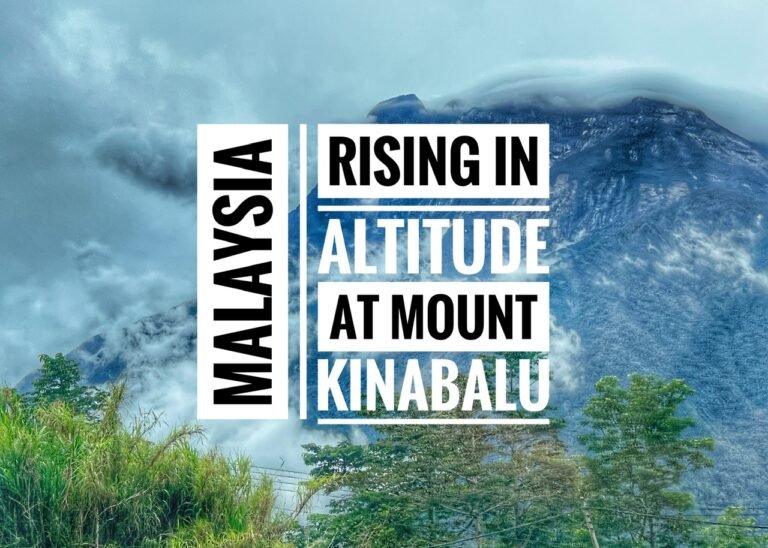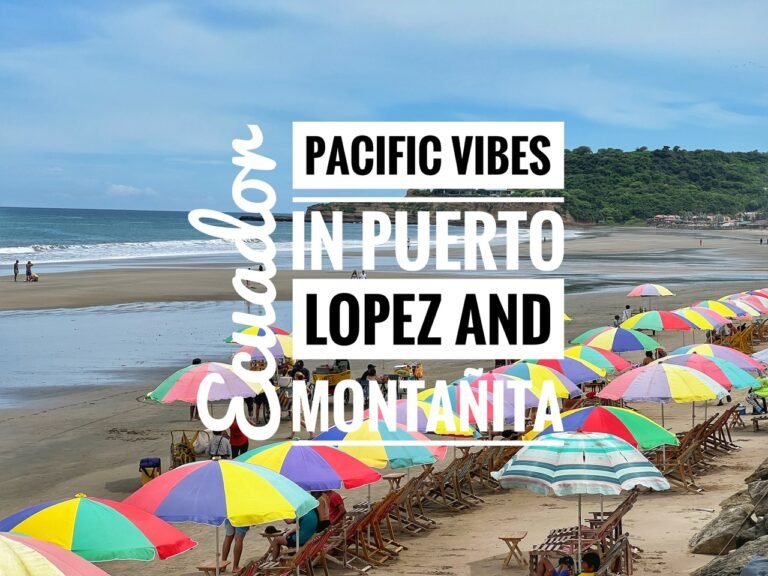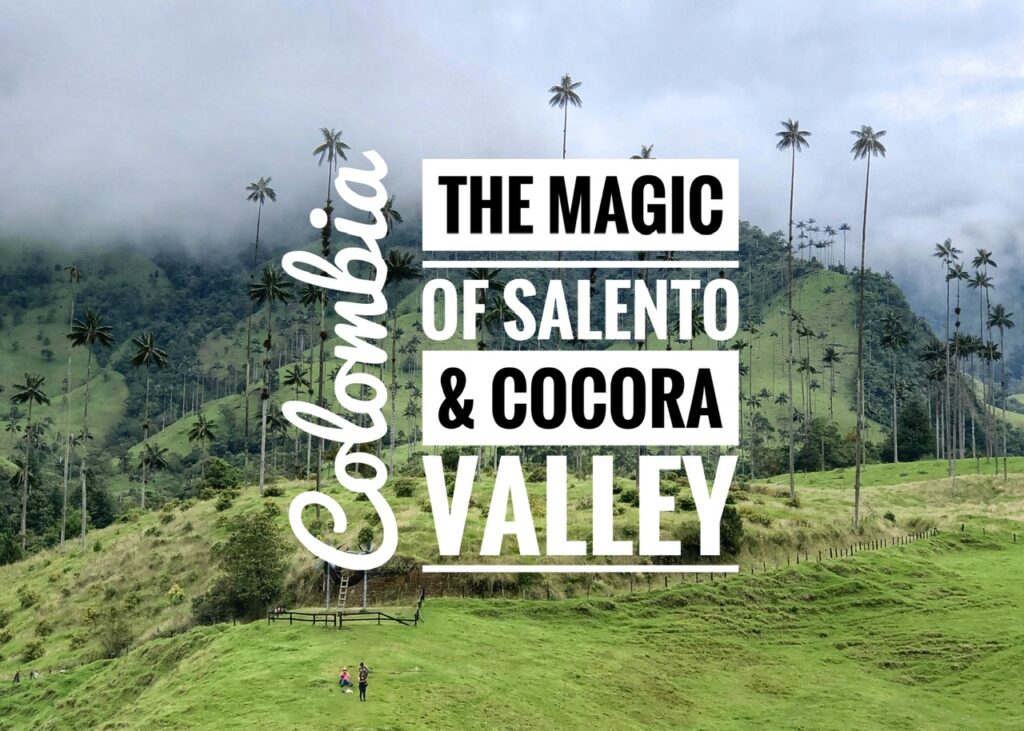
Salento is one of those Colombian towns that you’ll find in nearly every “must see” list for the country. It’s actually bewildering how many people head nine hours south of Medellin just to include it in their two week itineraries, totally bypassing wonders like Filandia and Jardin. But alas, we see why it’s attractive. It’s colorful, it’s happy, it’s tourist friendly, (most locals speak some English which isn’t usually the norm), there’s lots to do, and the food options are plentiful. It seemed like the perfect place to head 50 minutes from Armenia with our friends, Abby and Alex, for the first stop.
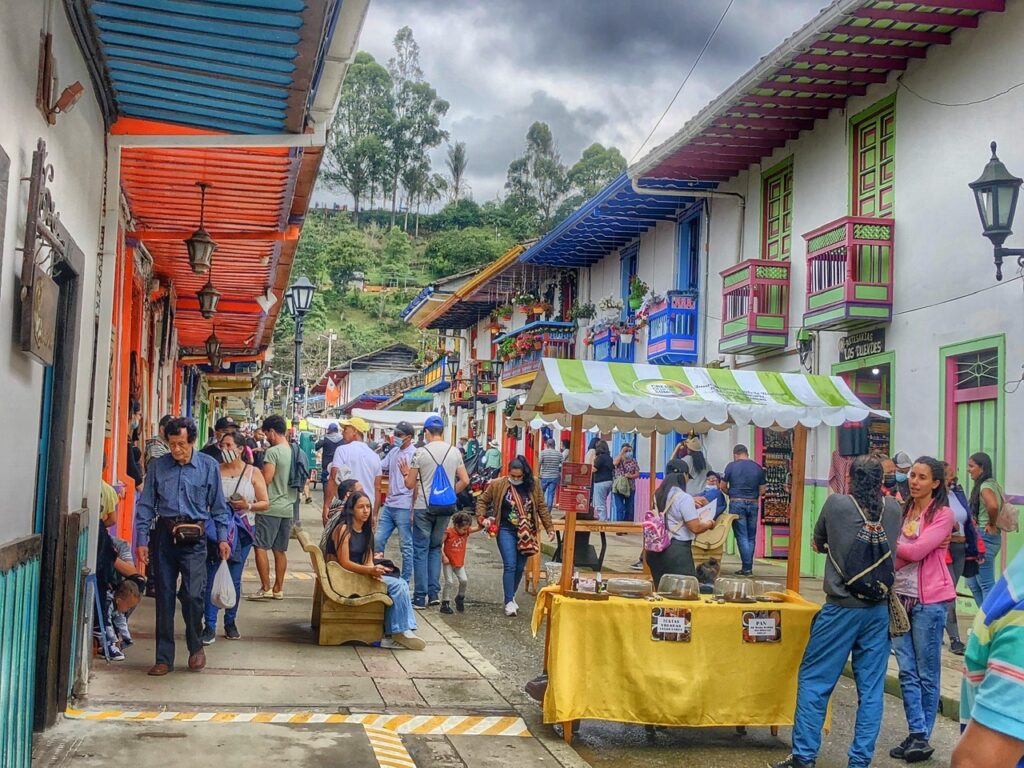
Exploring Salento
We arrived on a Saturday. The daunting time-for-hombres-to-shop Saturday before Christmas. And indeed, the crowds were thick and creamy. The streets were bursting with tourists, both local and foreigners and all the businesses were delightfully peddling samples of something…marmalades, cheeses, and pastries…in hopes that you’ll purchase something for your bota de navideña (Christmas boot…aka stocking!) And sure enough, it’s a good place to do shopping. Salento is inundated with quality artisan crafts like rugs, pottery, jewelry and t-shirts. It was also inundated with people not wearing masks. A sure sign of a tourist town anywhere it seems.

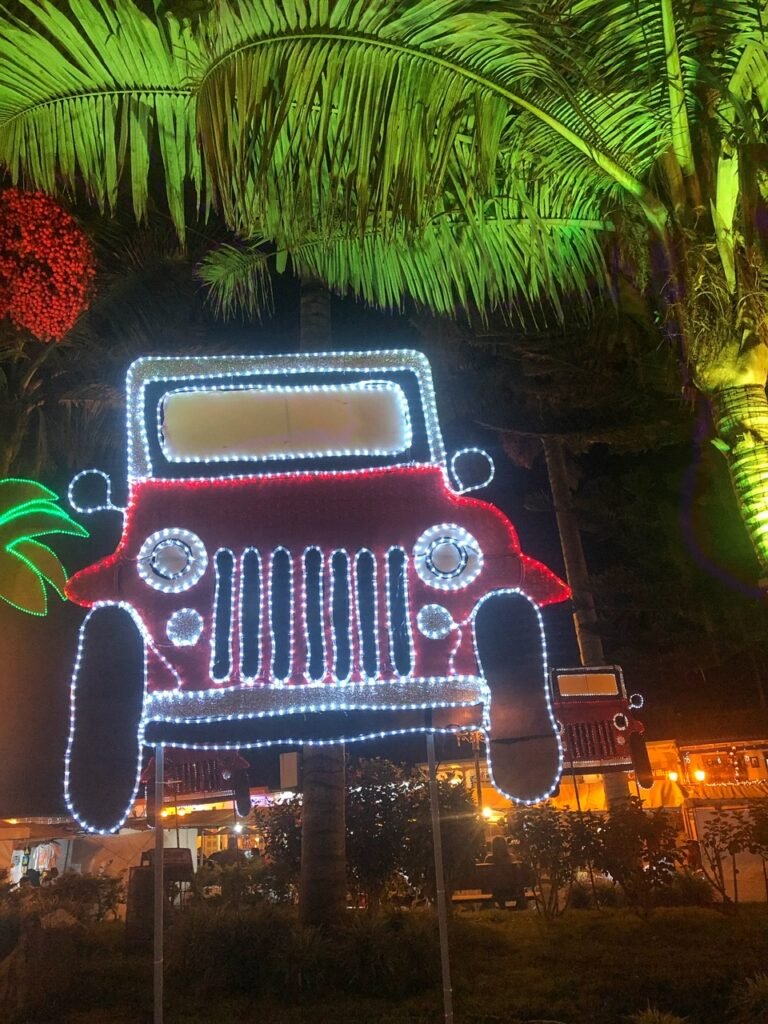
Salento, which is also in coffee country, is known for its Jeep Willys, which are constantly packed to the brim before hauling people out to the Cocora Valley. So, it’s only fitting that their Christmas lights would feature them as the starring attraction.
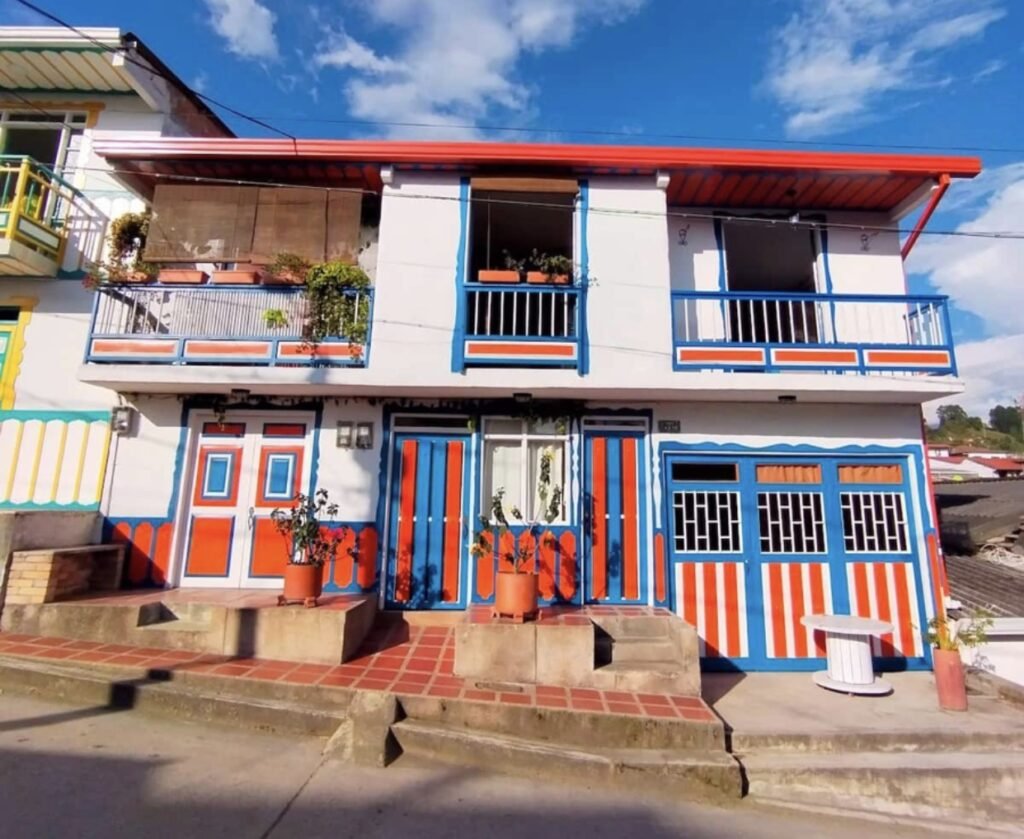
Our Airbnb we stayed in for three nights was $48 divided by 2. This is double what we paid for three bedrooms in Armenia. We noticed that overall accommodation was not surprisingly, much more expensive in Salento.

But it was a decent apartment for the four of us with two bedrooms, a full kitchen and bath.
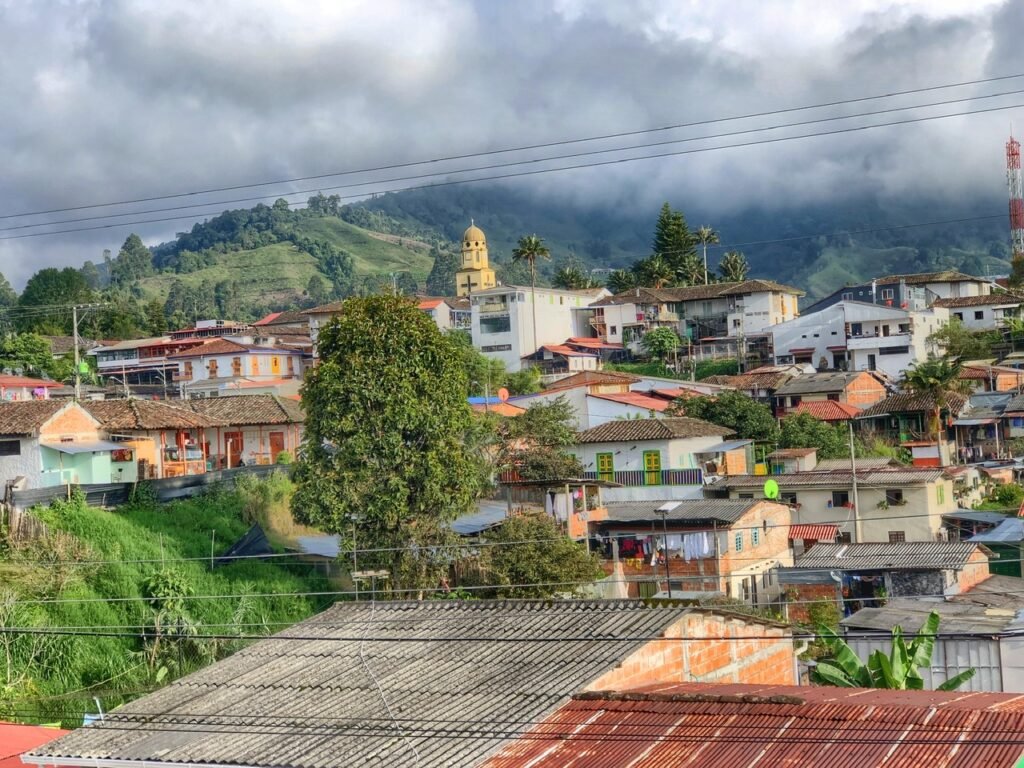
The view from our apartment window.
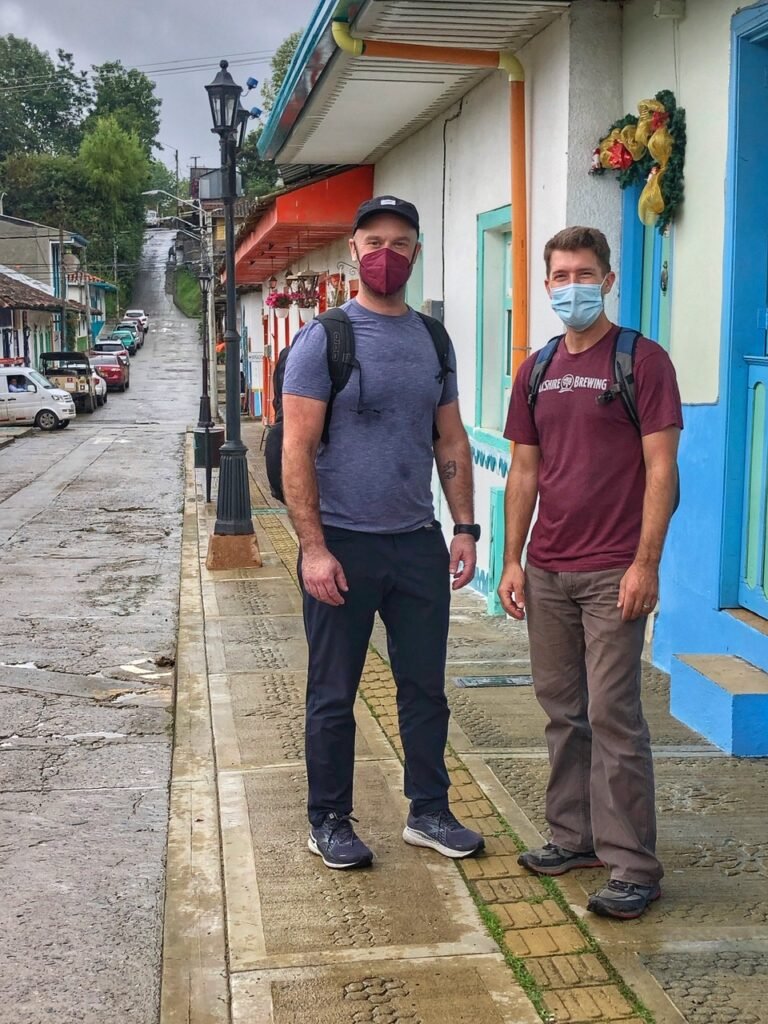
Greg and Alex showing off their manly masks.
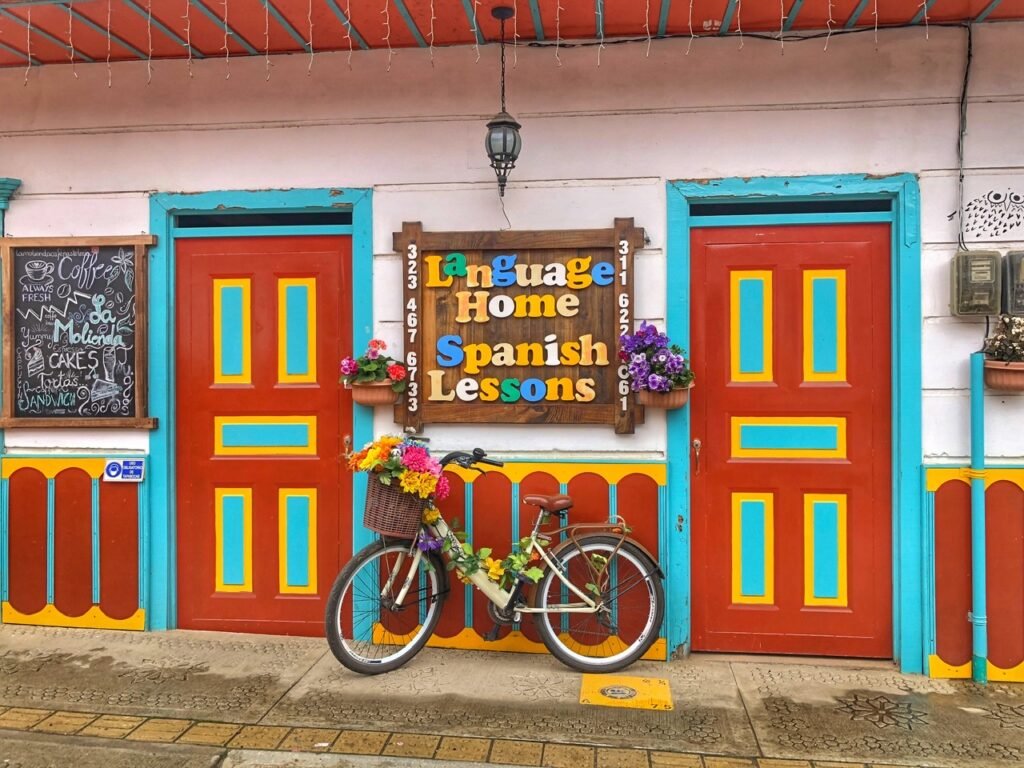
This language school was owned by our Airbnb hosts. We heard from others it’s a great place to take lessons. If only we had more time to grab some!

Abby’s first Menu del Dia at Rincon del Luci featured the usual (for us)…breaded trout, rice, potatoes, soup, salad and some unidentifiable bits of fried dough. Cost was $12,000 pesos or about $3.
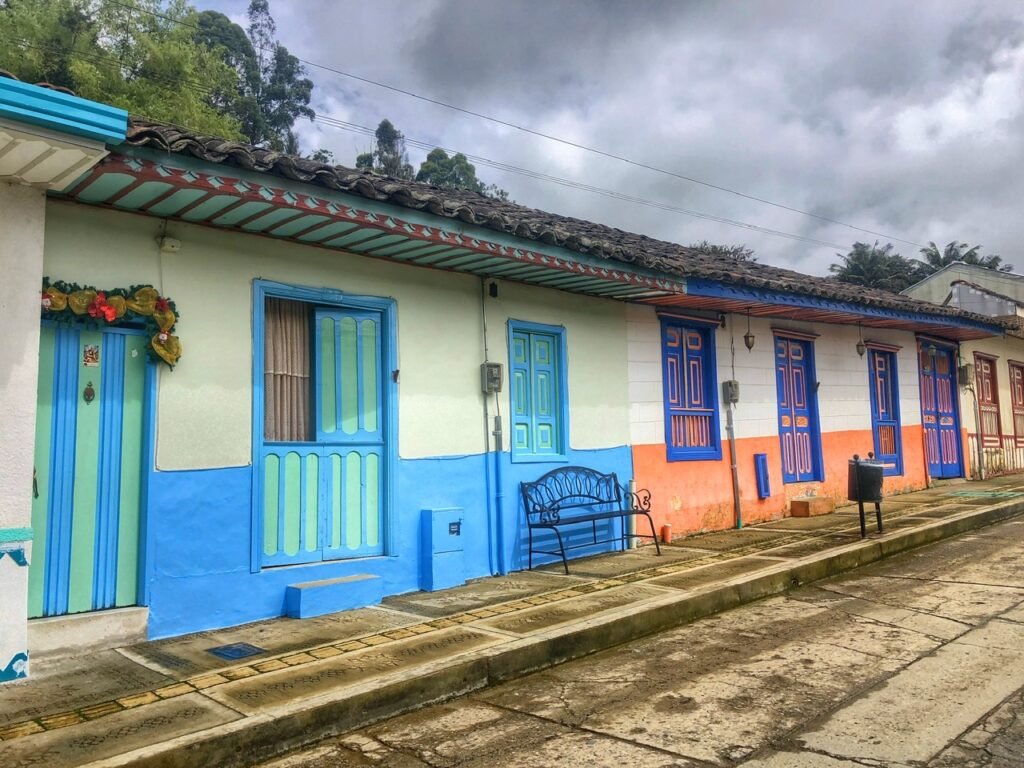

The streets of Salento were equally as brilliant and ravishing as other places we’ve visited in this region. We didn’t really think the town had a leg-up in terms of its architectural offerings, however. Not enough to elevate it to such tourist status.
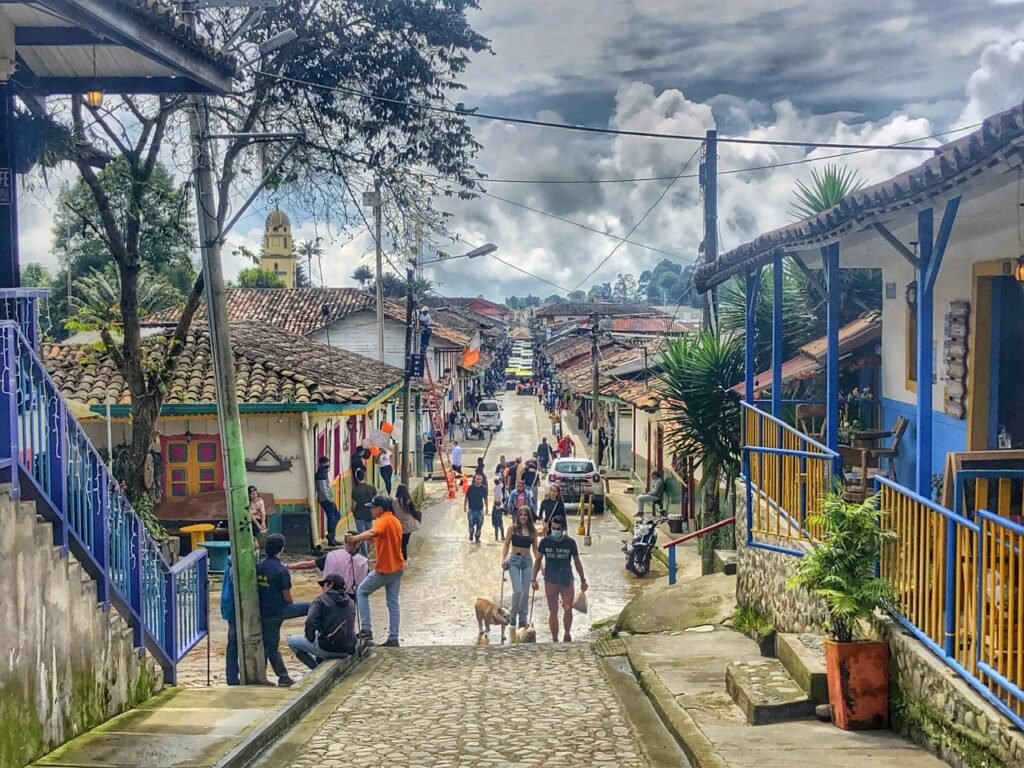
The cobble-stoned pedestrian walkway in the middle of town.

Eight months following an intense accident, heading up the mirador was Abby’s first feat in a series of physical training exercises she would endure while in Colombia. We were delighted to see our friend make incredible progress on her visit.
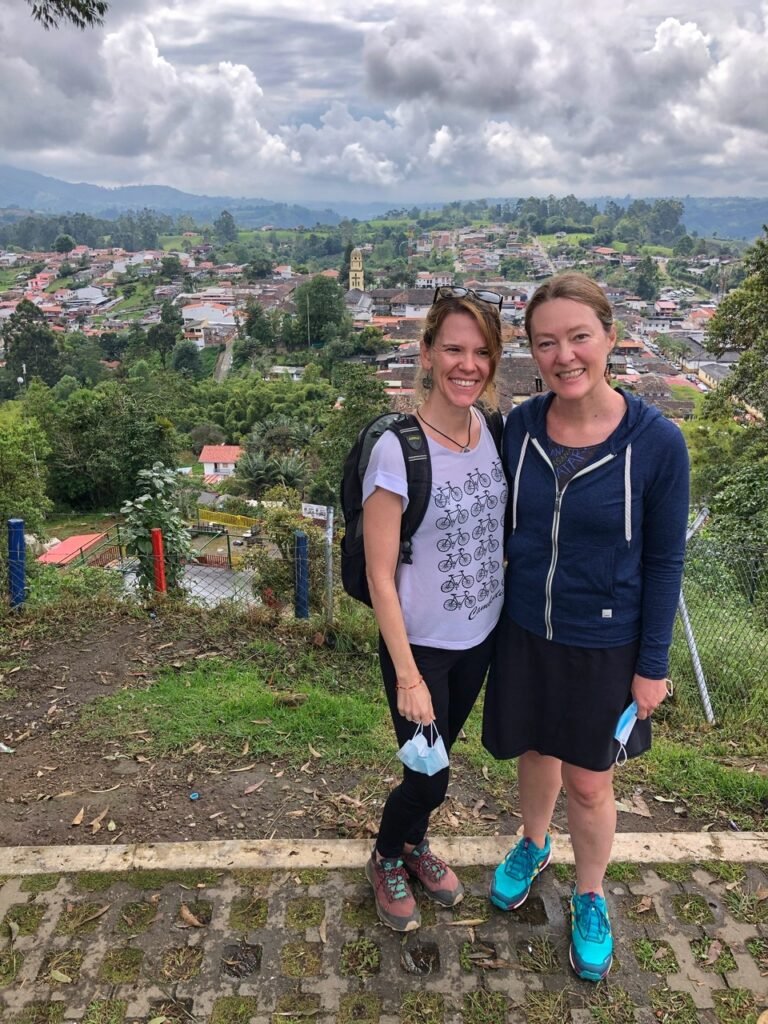
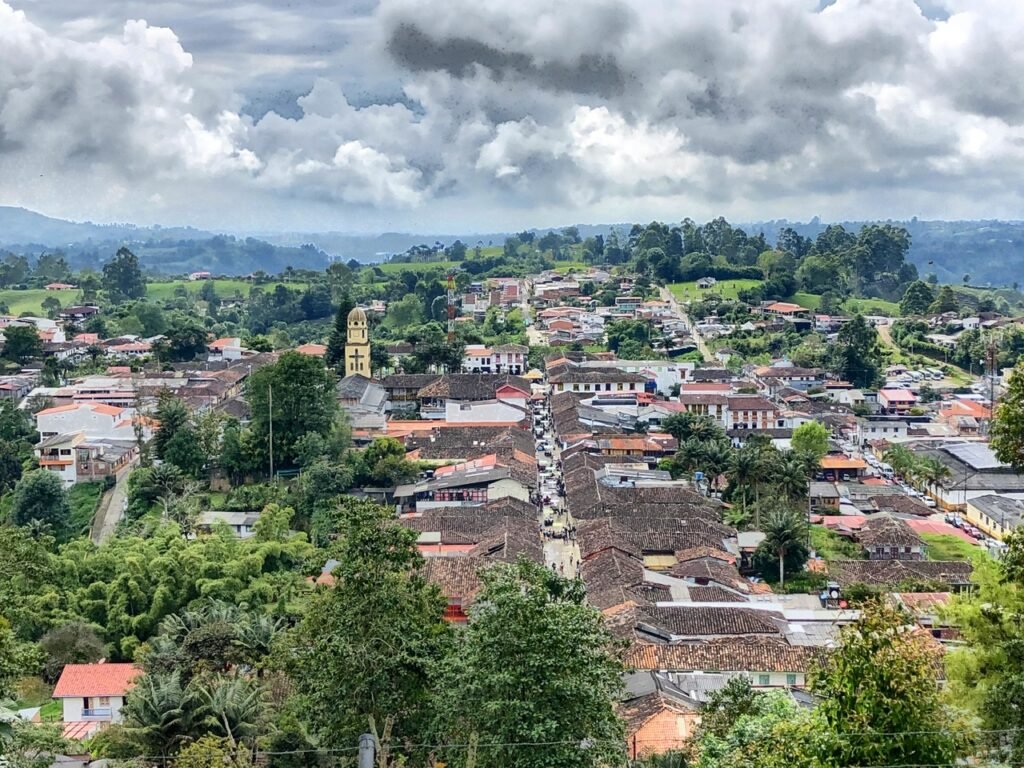
At the top of the mirador, Alex and Greg decided to both take the ladies photos…which is why they’re grinning in two directions. Haha.
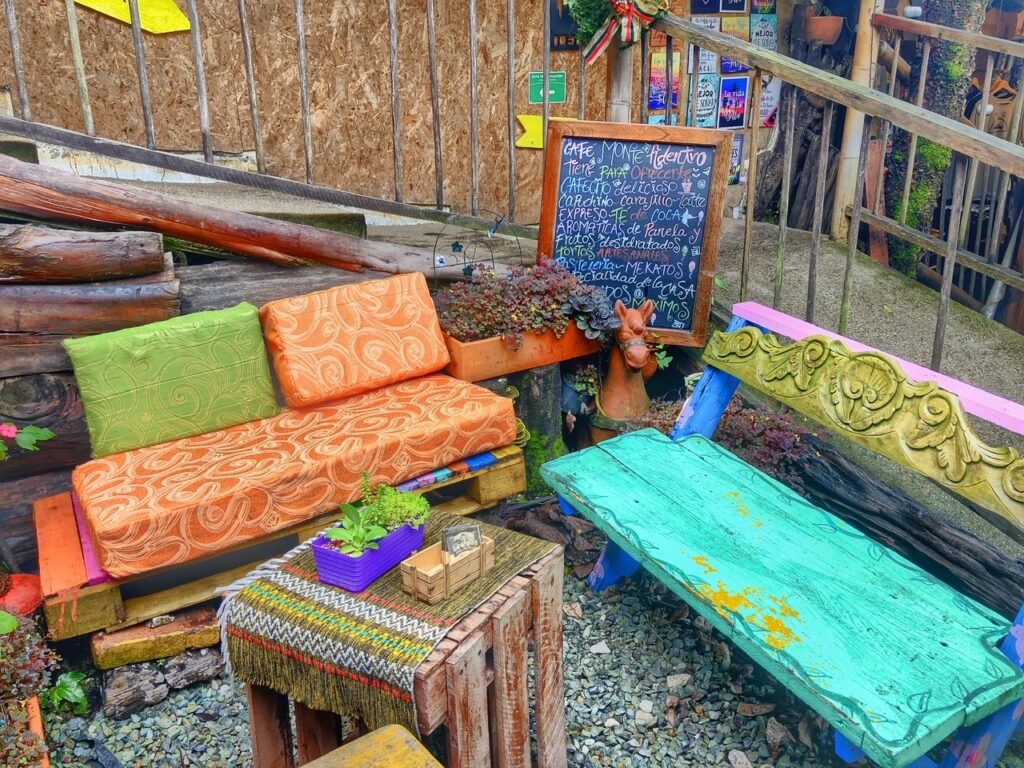
One of the many adorable cafes to grab a coffee in.

A fruit vendor selling all the tropical goodies…mango, papaya, coconut, guava, chayote, and watermelon. One thing that we love about Colombia is that fruit doesn’t seem to go to waste. Once it’s past its shelf life, the grocery store resells the fruit in frozen form for about $.50 a bag. Perfect for our smoothies which we have almost every morning!
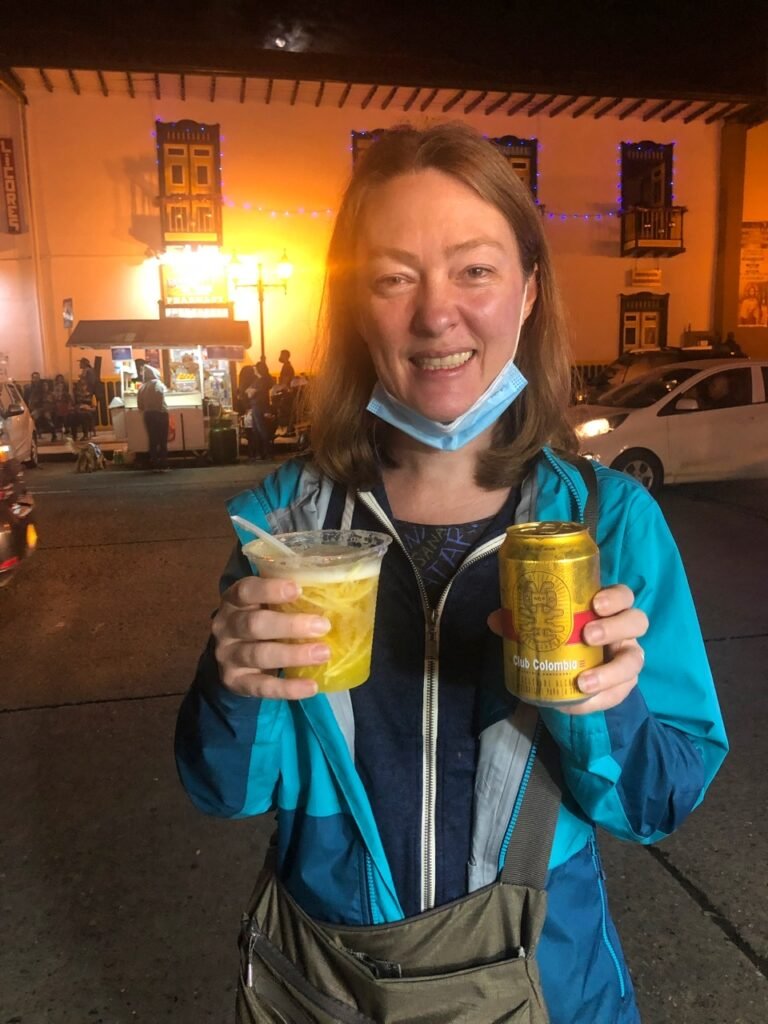
Mandy introducing Abby to her first Michelada. This time in mango form, which basically means grated green mango served like a floating marsh inside a beer with a salted rim. For the record, Micheladas in Colombia are not Micheladas in Mexico (where they are served with a Blood Mary type mix). To be frank, they suck. But Mandy continues hope she’ll find a good one here. Needless to say, Abby immediately wrinkled her nose and was not enthralled. At least it was only a $1.

The main church in Salento. Not overly eye-catching when you compare to some of the other recent churches we’ve seen, but still pretty.

Hanging out in the parque principal (main square) with our drinks enjoying people watching under a full moon and Christmas lights. (Note: I was told by my Colombian Spanish teacher they are not plazas in Colombia but parque principals.)

Running into the sweet owners of our AirBnb, Julieth & Fausto. They were dressed to the nines to head out on a date to eat super patacones. Patacones are plaintains and they were eating them pounded out and topped with meat, cheese and vegetables. So, we concluded…a patacone pizza.
Abby and Alex later went to the same restaurant and said it was a bit of a dive bar, so we found it incredibly endearing they had made this a date night.
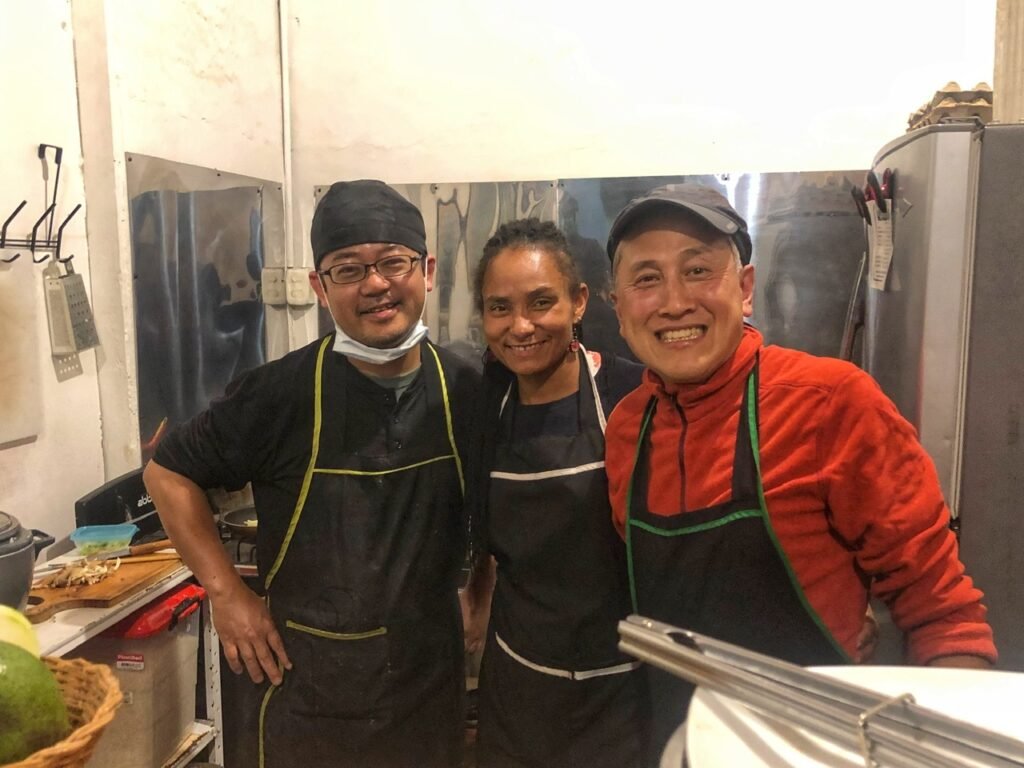
As mentioned, Salento has plentiful restaurant options and one of them was…Japanese(!) at Wasabi Artesano, which was a fantastic change of pace!! They had a great mix of Japanese dishes and we were impressed by their kind staff who spoke Japanese, English and Spanish! Jealous!

A Vintage VW Bus/Truck combo on the streets of Salento. So funky!
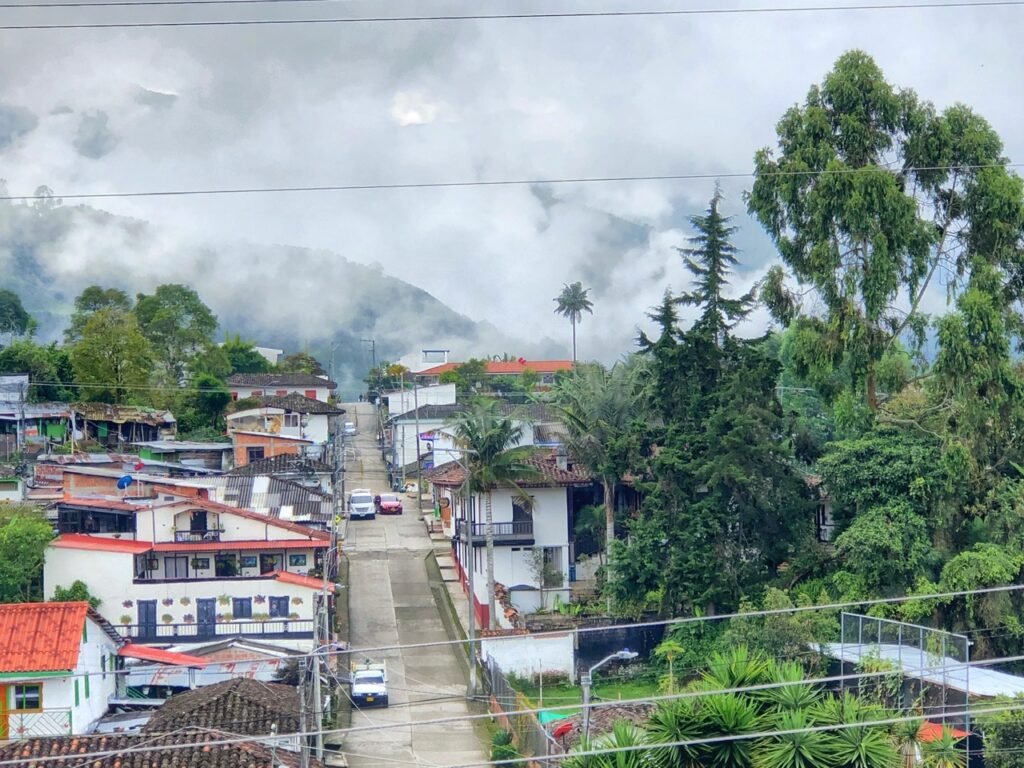
Buckets of clouds greeted us every morning giving the town an ethereal look, but fortunately not too much rain.

Monday morning was much less chaotic on the streets of Salento. Oh yes…we liked it.
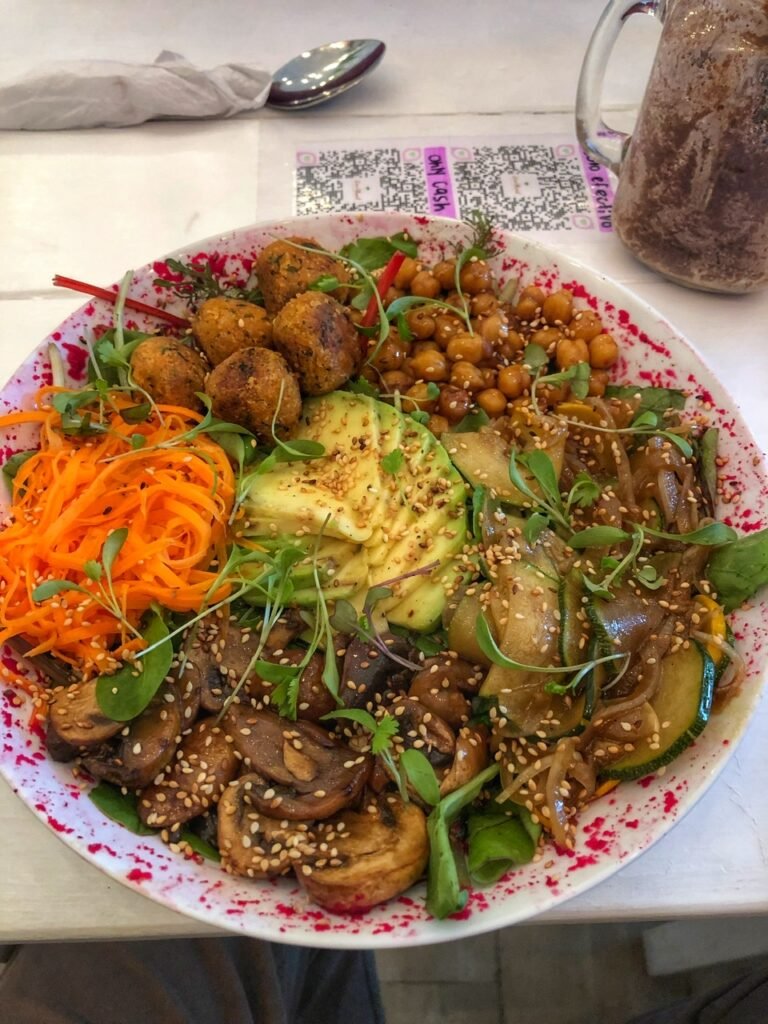

Lunch at Coco Bowl, a healthy vegetarian and vegan restaurant. Unfortunately, the food looks a bit better than it tasted. But at least they had the right idea.
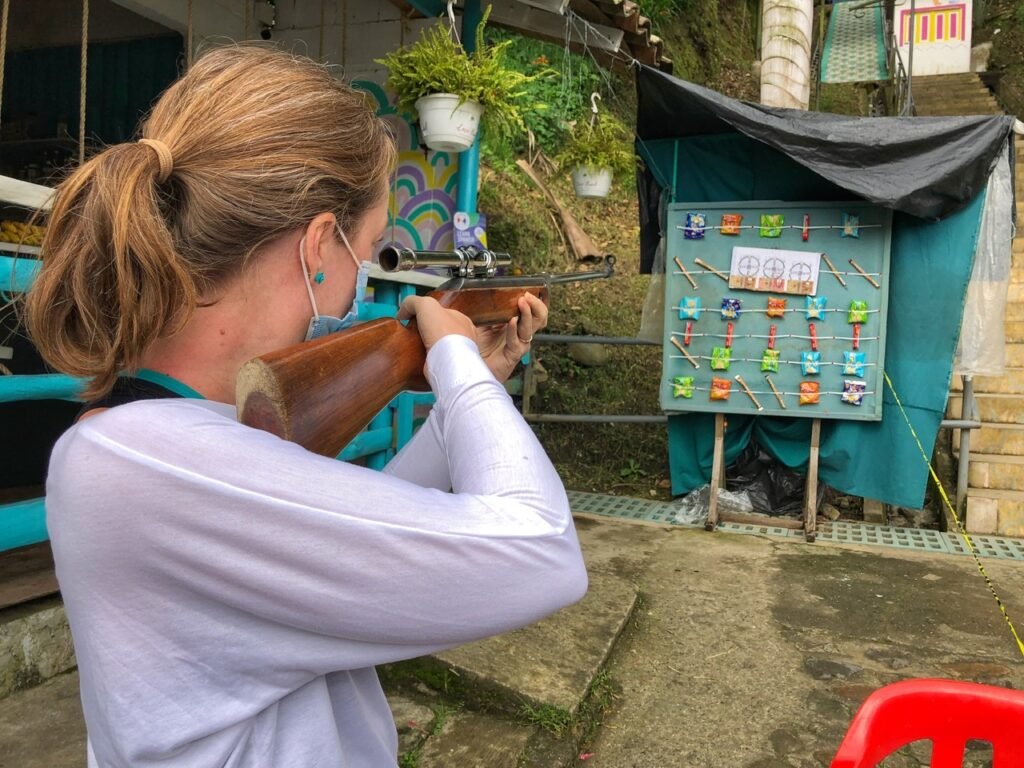
Abby taking aim in an attempt to win plantain chips. She didn’t.
The Hike to Santa Rita Waterfalls
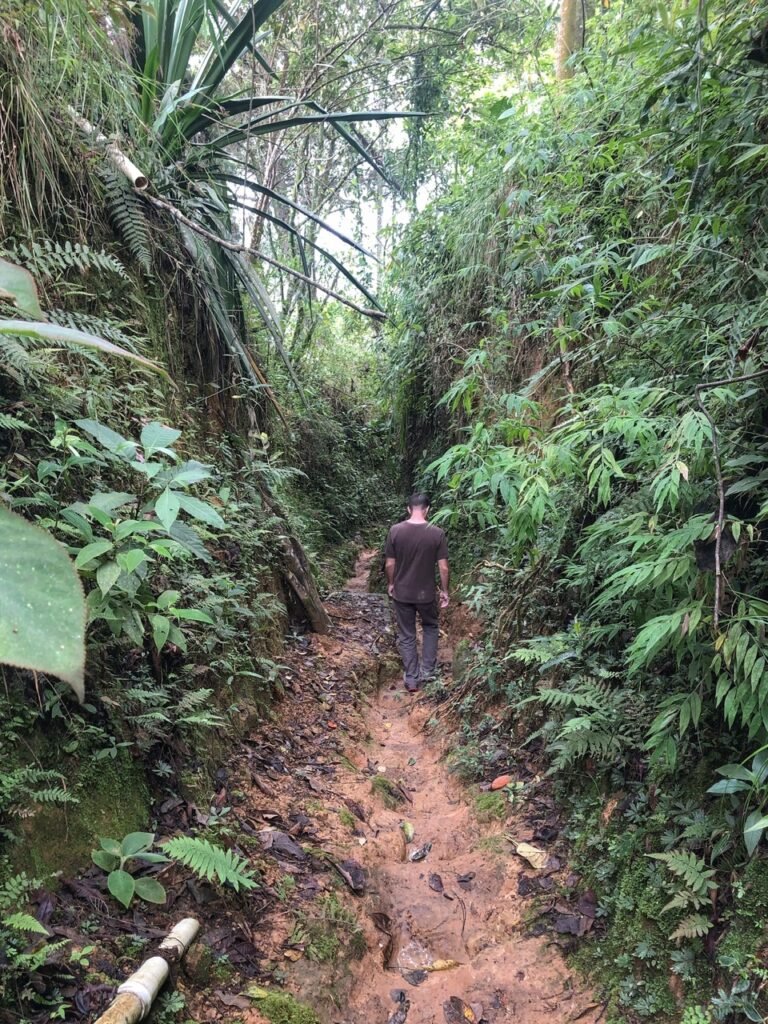
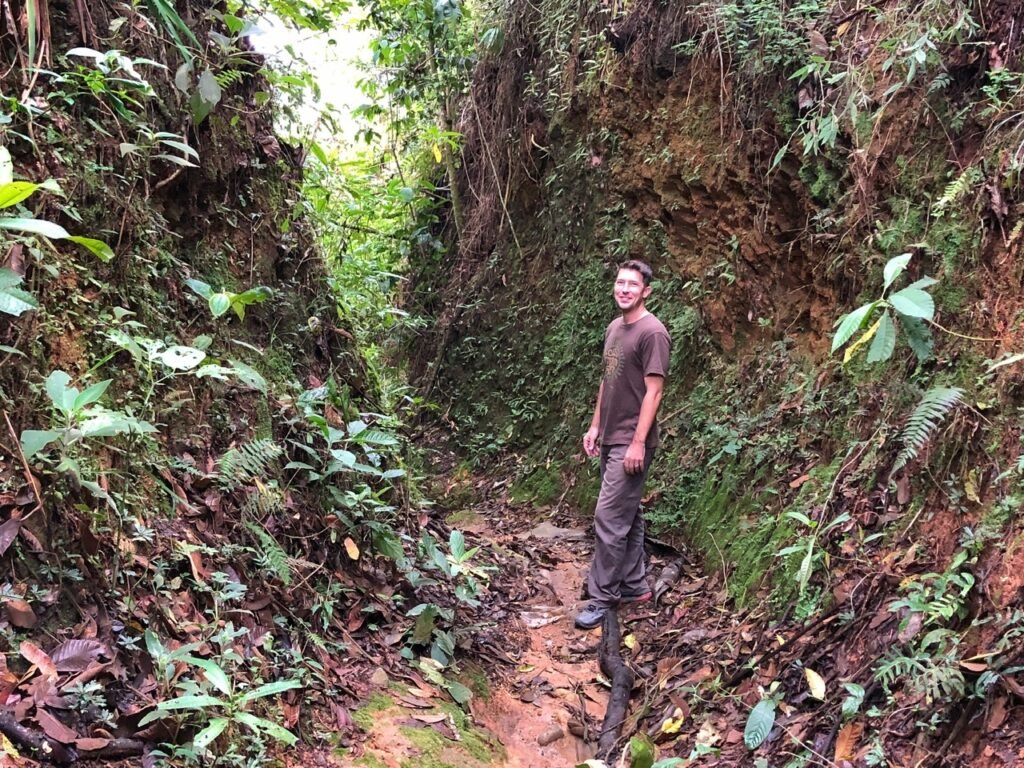
The first activity of another day was to hike to the Santa Rita waterfalls and natural area, which is a good 7 km from the tourist town of Salento. So, we set off to walk the full shebang with Ranger Greg, at the lead because according to our trusty Mapy app, we could…. What the map didn’t show was how rugged and narrow the first section was or how long it would take. Fortunately, on the return, we grabbed a bus and made a new abuelita friend, just in time to make it back for our afternoon caffeine injection (coffee tour.)
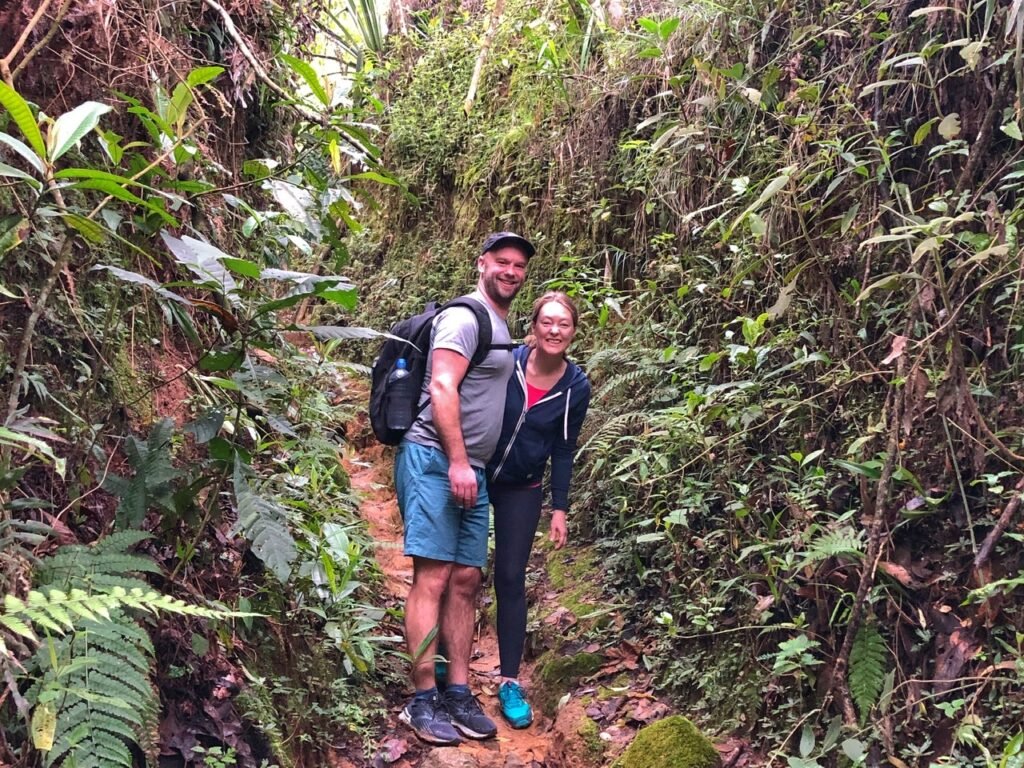
Alex and Abby. We couldn’t have been happier that Abby was able to hike with us. Even on this semi-strenuous trail, once she pushed herself a bit she realized it was a necessary part of her recovery.

Crossing the river you’ll noticed a tree house far up in the tree, one of the many many glamping accommodation options near Salento. We actually looked at a couple of these but decided we wanted to stay in the town.
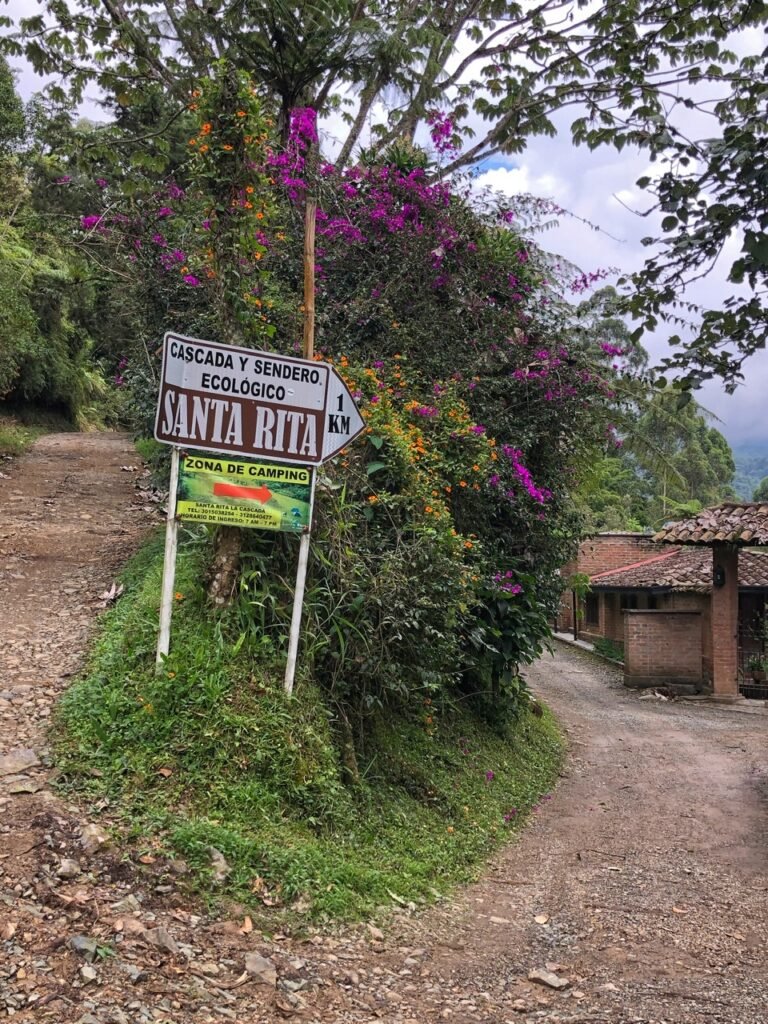
An hour and 15 minutes later, we arrived on the actual trail to Santa Rita. We came to a finca with a obtrusive sign that said “PARE” (stop) and two bad-ass looking elves who said they would deny us Christmas presents if we didn’t pay the $7000 pesos ($1.75) to go any further.
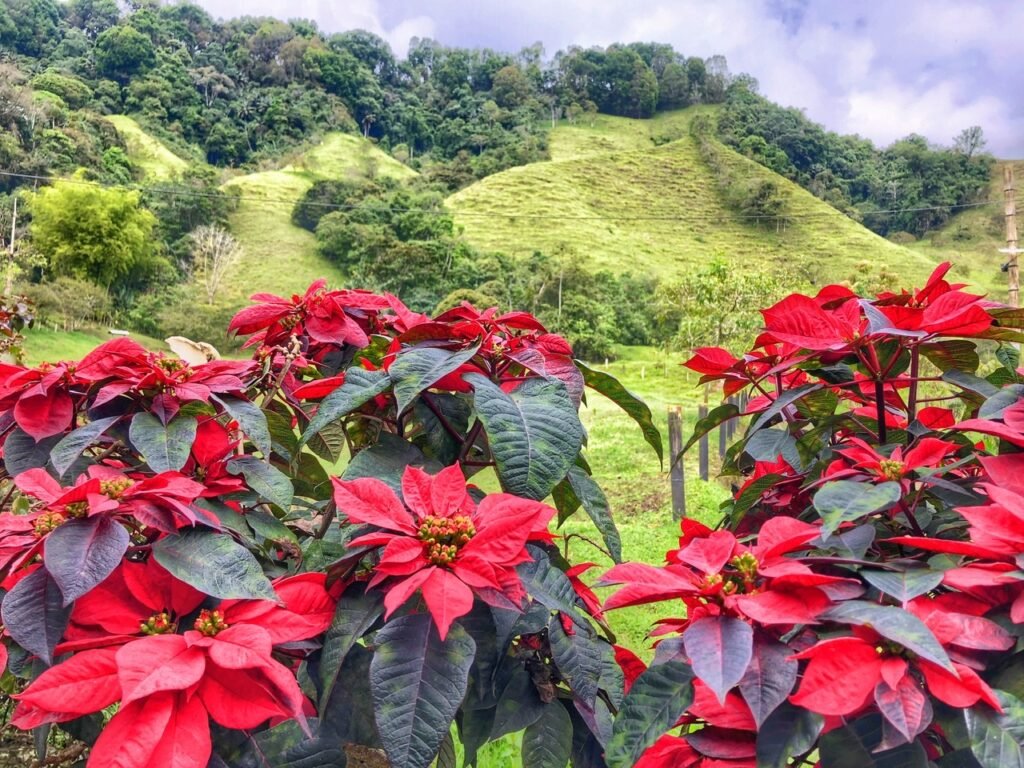
It’s Navidad season so it’s only appropriate we would see a poinsettia bush! Note: did you know the poinsettia is native to Mexico?
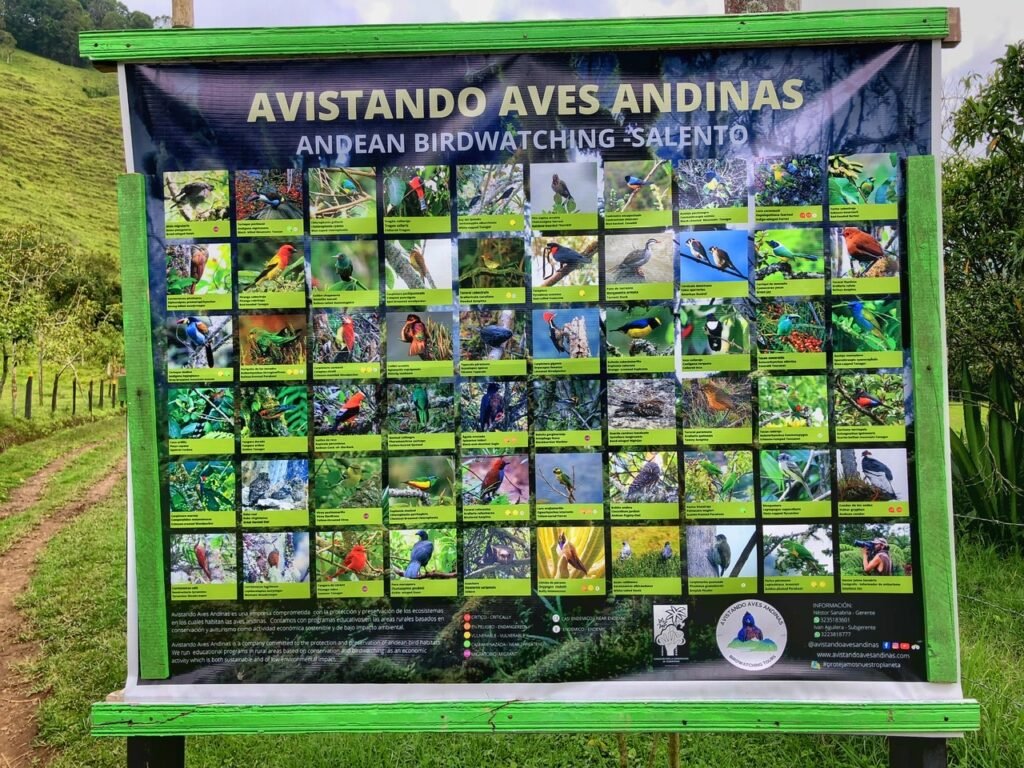
If you’re a birder, this area is your birdvana.
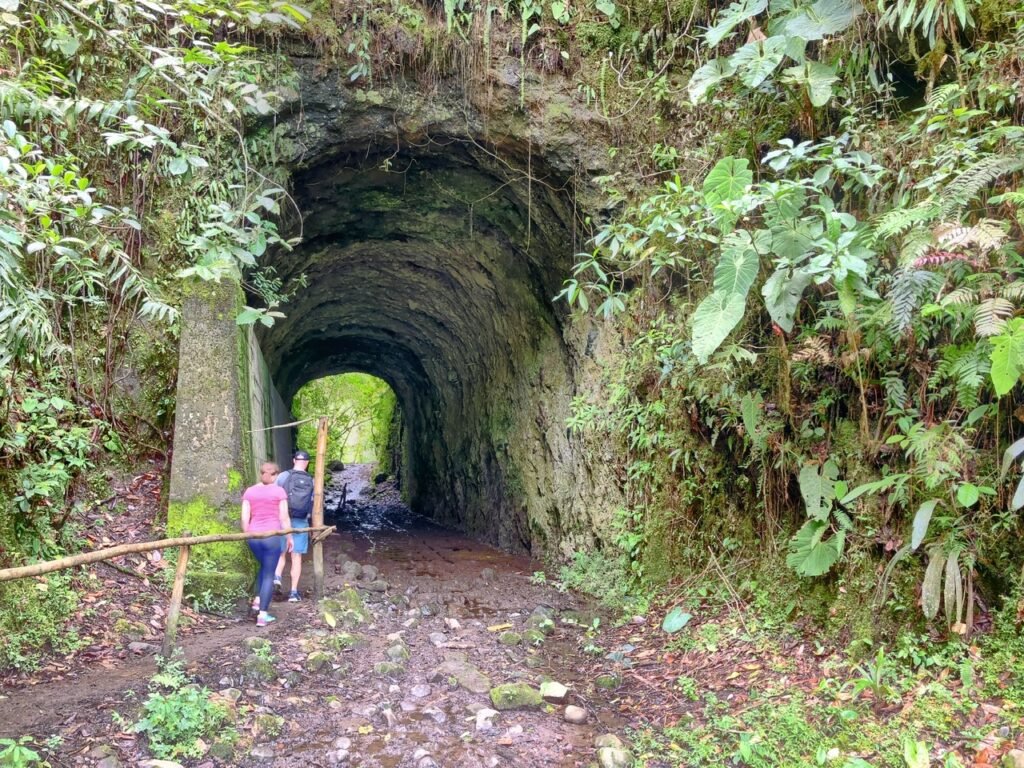
Crossing through one of the old train tunnels on the hike…
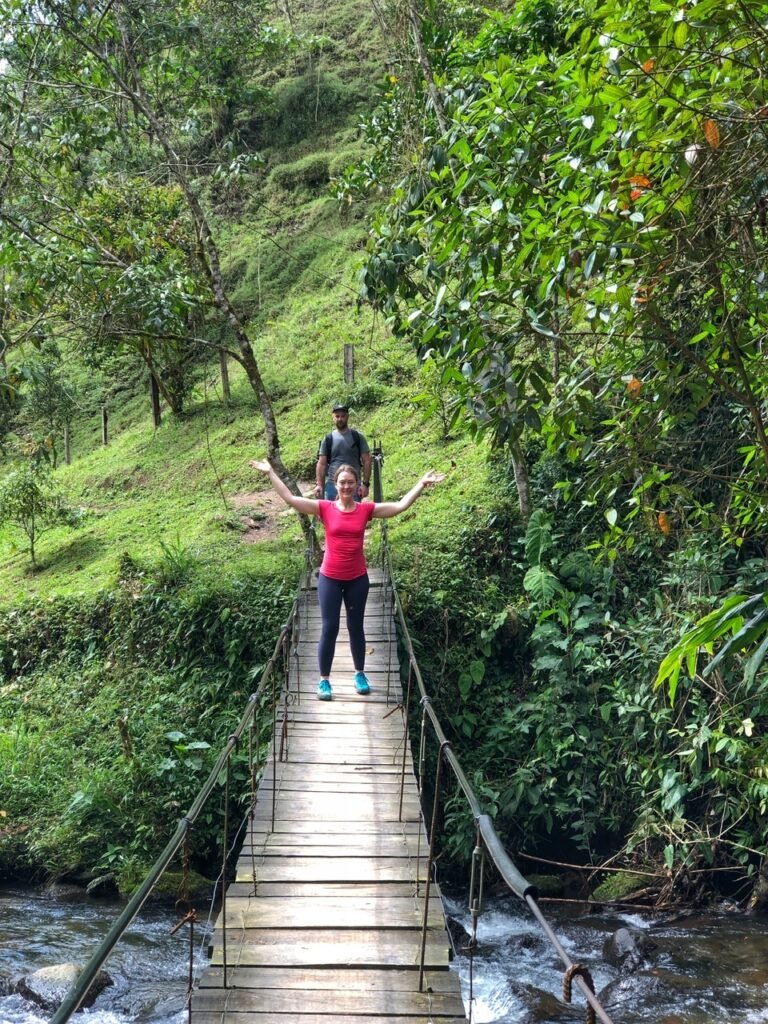
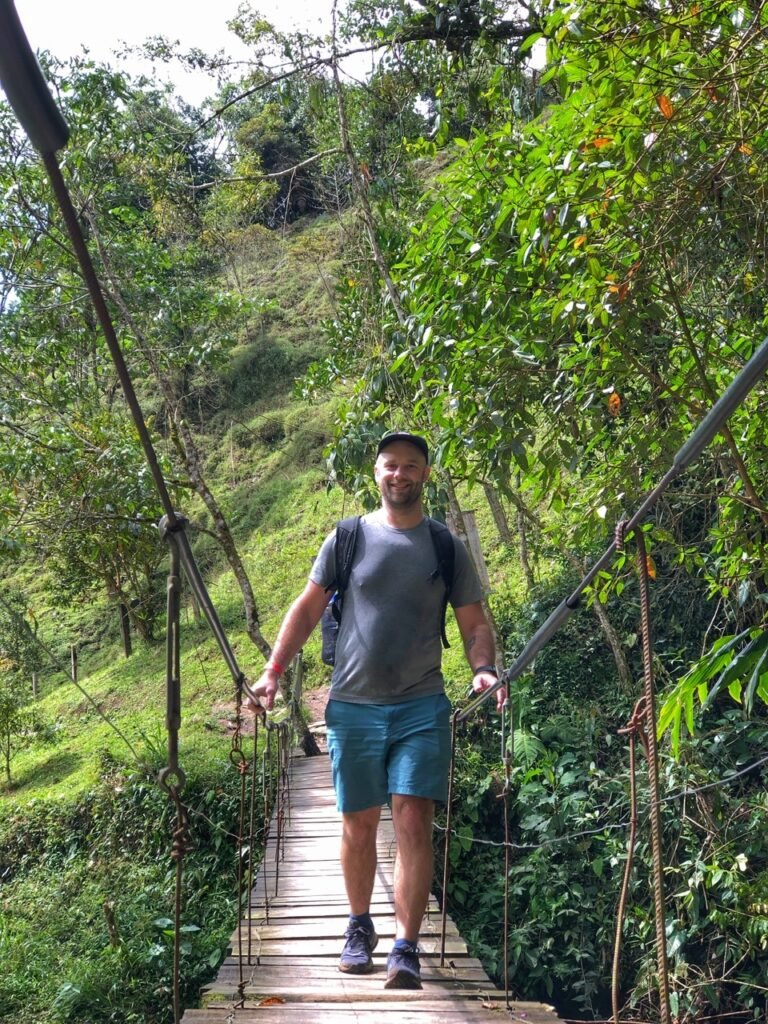
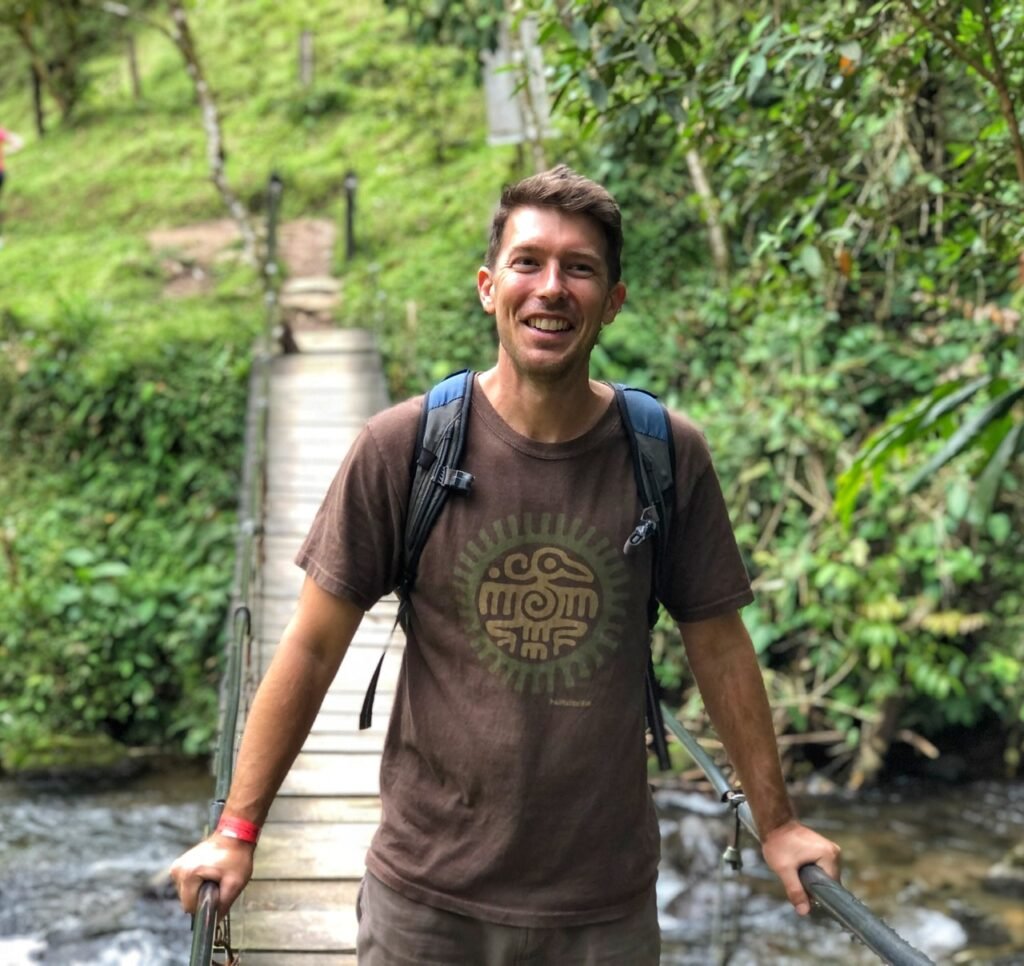
…and one of the many suspension bridges which wobbled like jello all the way across.

Once we crossed the bridge, we were surrounded with an absolute swarm of tiny orange and black butterflies for several hundred feet before arriving at a food stand serving a selection of chorizo…or chicharrón. Oh Colombia…. From here there were several trails to different sights.
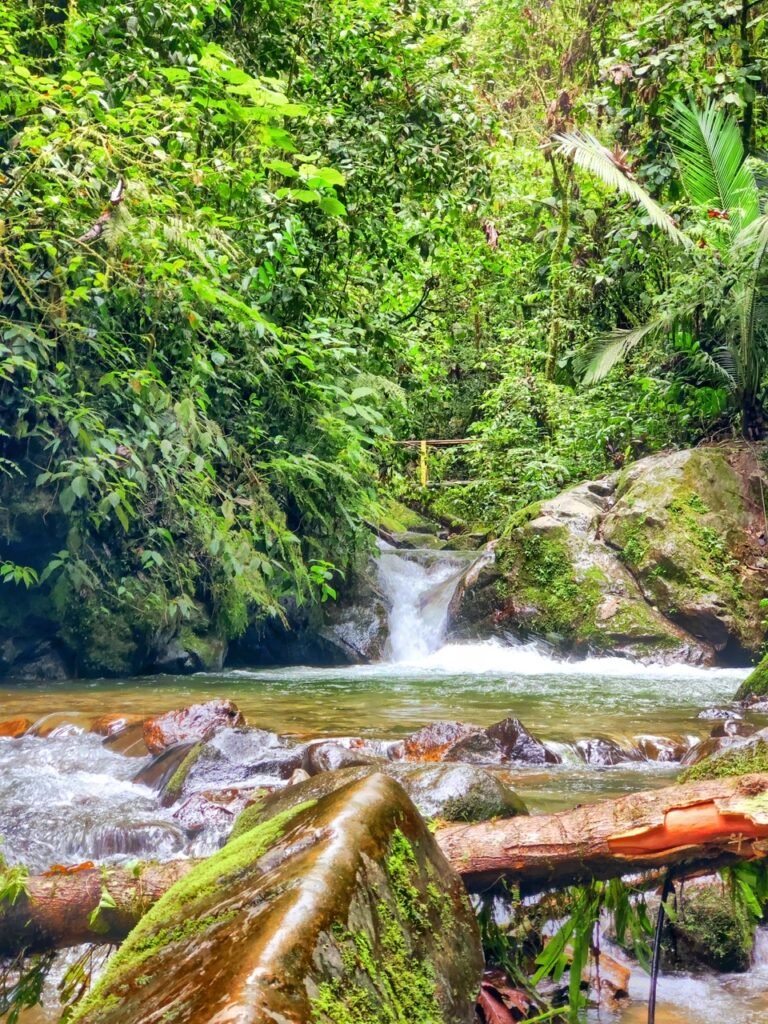
The first of those was the natural pool where swimming was a possibility, but considering the air temperature was in the upper 60’s, it didn’t really feel like a fun thing to do.
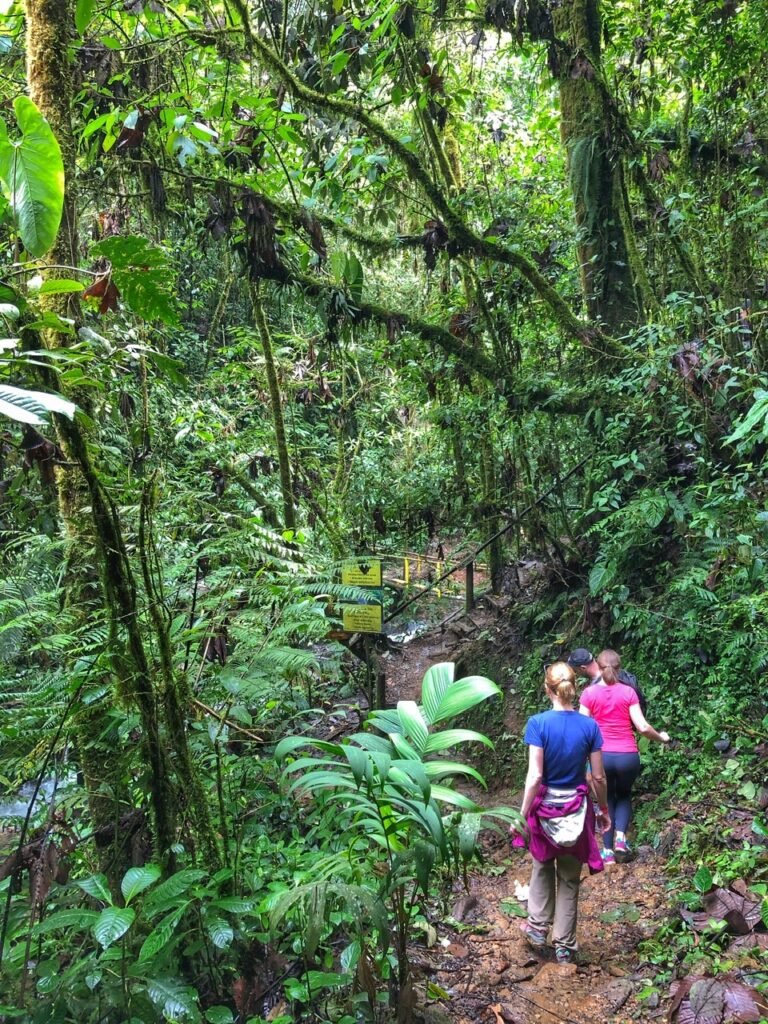
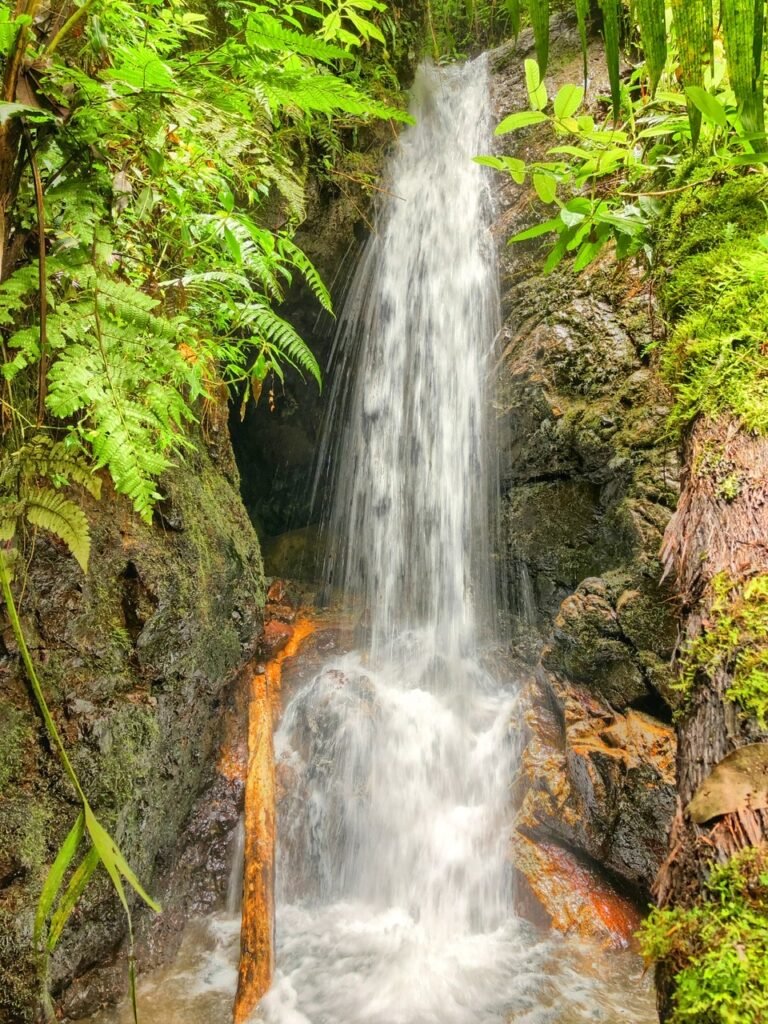
The forest got more and more succulent as we continued on, as spotted another waterfall tucked in the green.
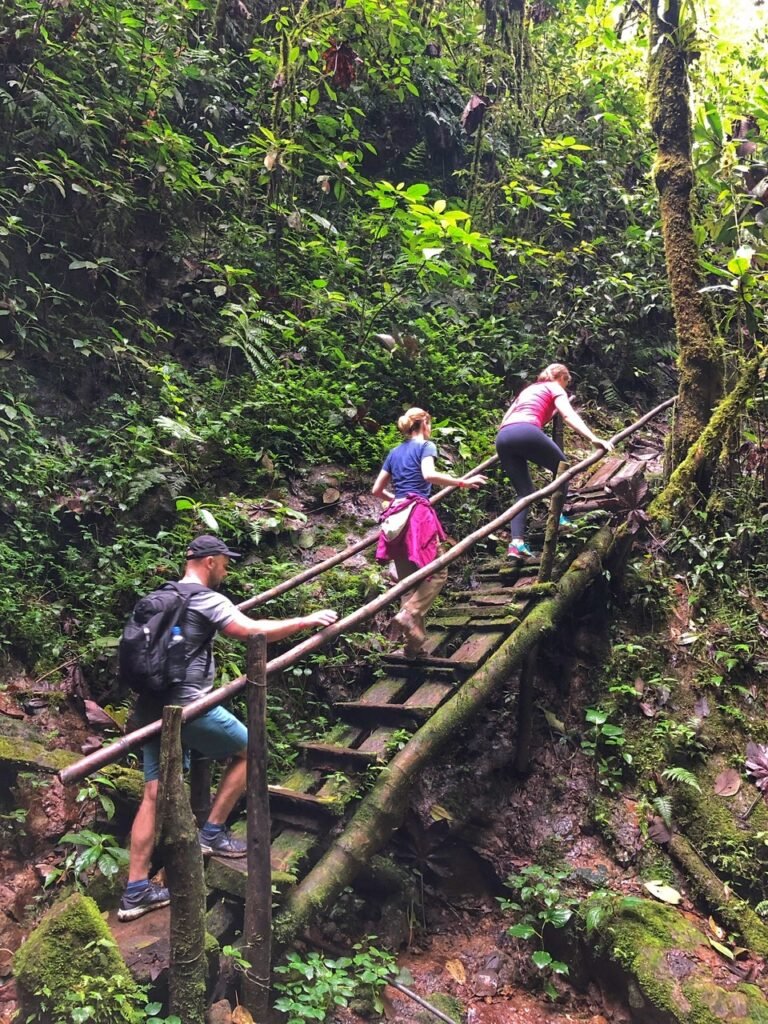
It was so great to be hiking with our friends!
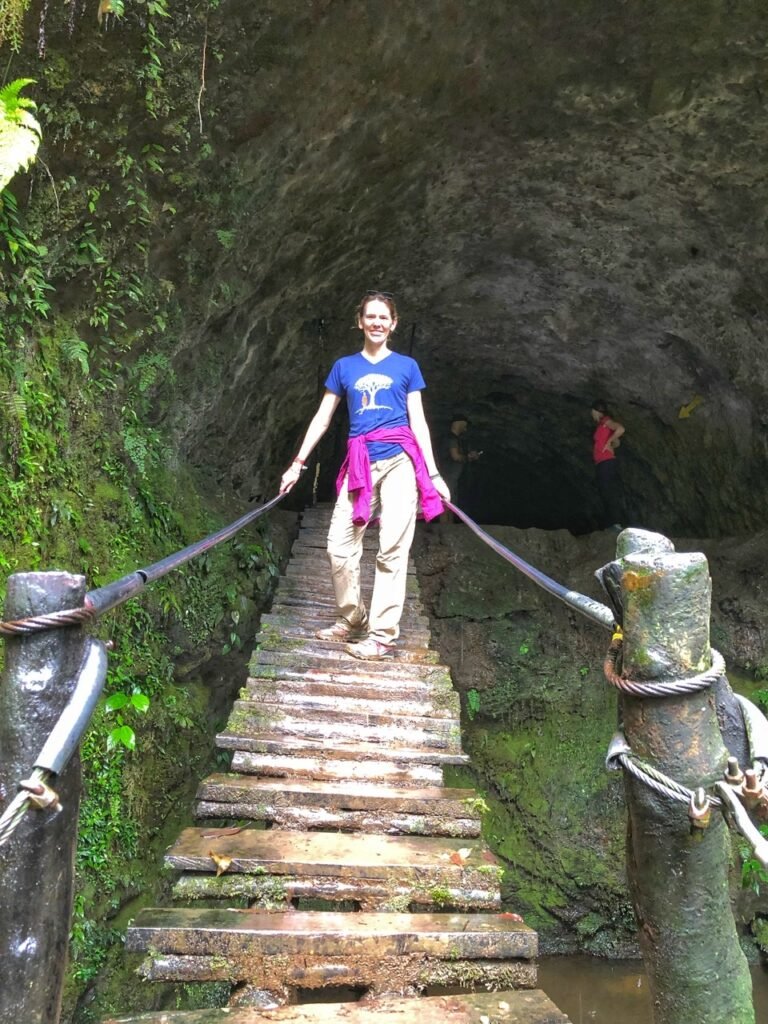
Into the Bat Cave.
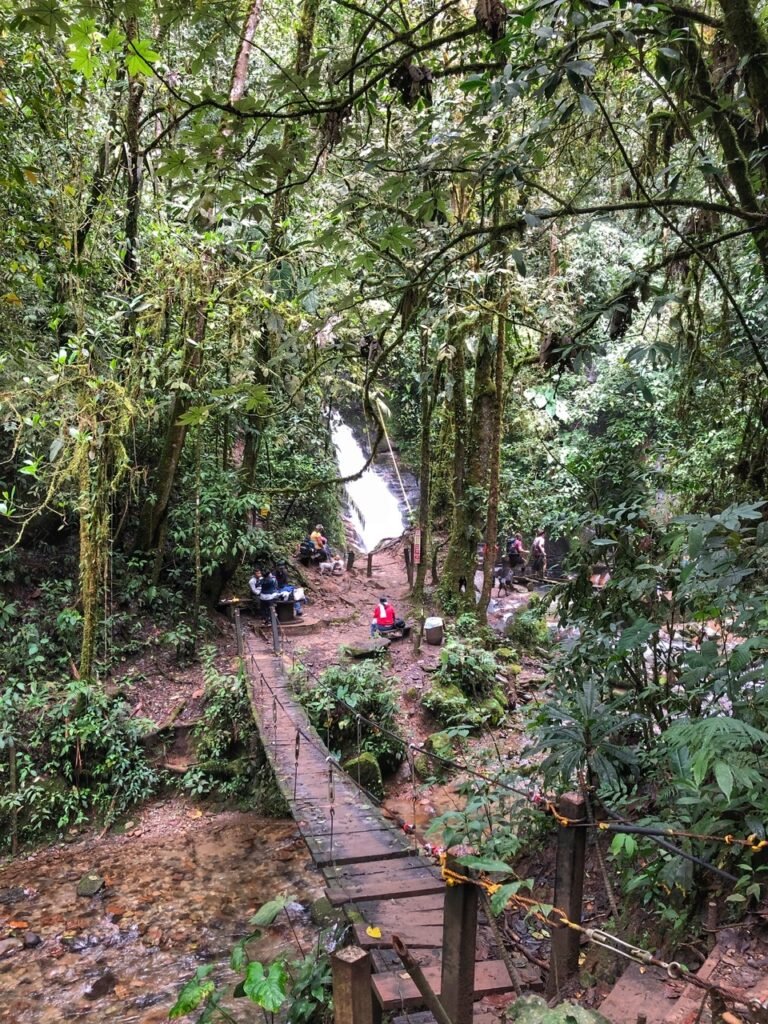
Arriving to the main event of Santa Rita Waterfall was the only area it felt a bit congested on the trail.

Making it to the main waterfall to see this woman dangling like an ornament in front of it.

On the way out, the elves at Santa Rita Finca encouraged us to grab a photo with a Santa (who clearly needs to eat more chicarrón) and his reindeer…errr…holiday bovine. After a couple photos, he gave us some non-marijuana-laced gummy candy as there seems to a tragic candy cane absence in Colombia. The elf who took our photos had moved to Armenia with her Colombian husband six months prior from New York City. She was loving her new life.
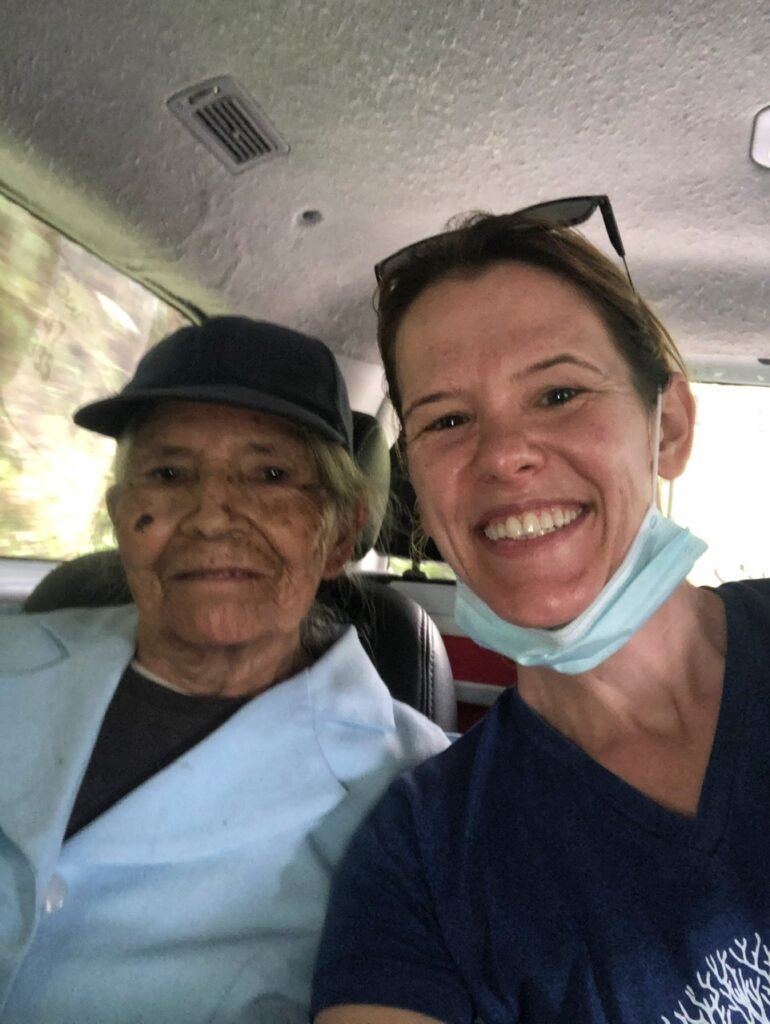
Mandy made friends with an 84-year old abuelita on the bus ride back to town. She said she takes the bus everyday up the hill and walks all the way back down with her groceries, which was at least a couple miles.
Coffee Tour & Tasting Workshop at Finca Momota
Two activities in one day?! Yikes! We must have indeed been wayfaring with our go-go-go American friends because we were getting exhausted already ? We had been in coffee country for over a month, not to mention Panama’s version, and we still had yet to dive into the full arena of where exactly that daily caffeinated injection is born. Therefore, we figured this was an ideal activity to do with our visiting friends and in fact, signed up for a extensive four hour tour and Coffee Tasting & Lab Workshop at Finca Momota.
The coffee farm (finca) was in a great location about a 10-minute walk from our place in Salento and is run by a friendly Spanish expat named Carla who moved to Colombia many years ago from Barcelona. It was well worth the $120,000 peso splurge ($30/each.) It gave us the opportunity to learn about the coffee growing and production process, including different varieties and how they’re harvested and fermented.
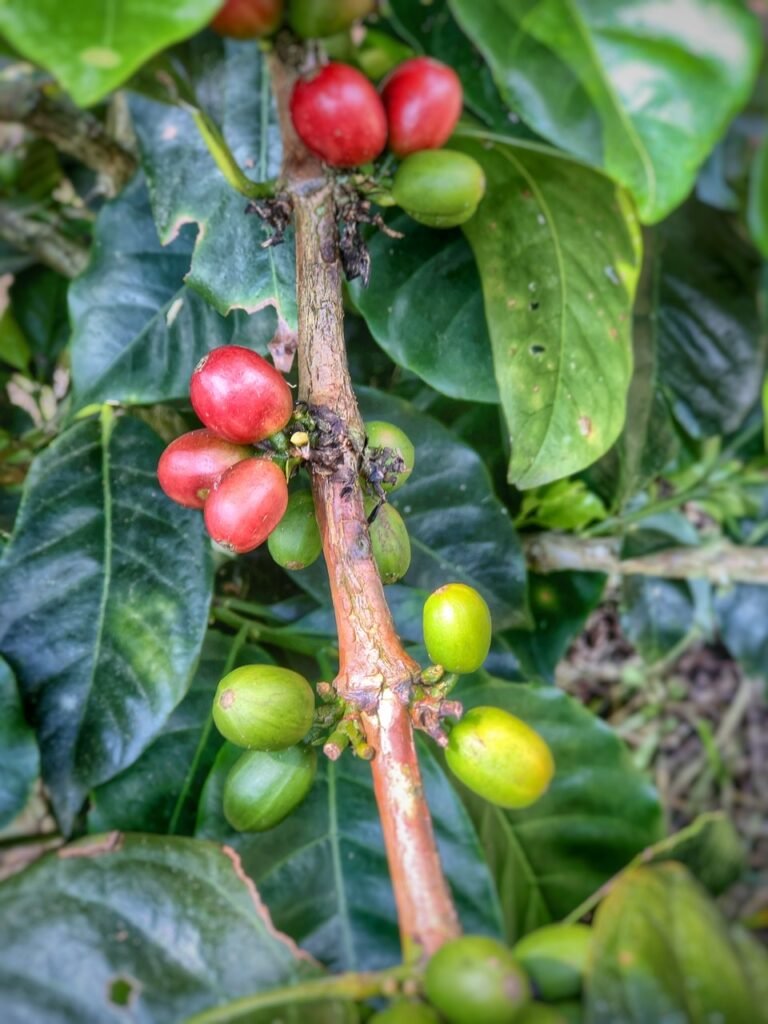
Before they hit your cup, coffee cherries look like this in their most basic form on the coffee plant. They are ripe when deep red and the green-ish seed inside is what becomes the coffee bean. The real doozy? 100% of these beans have to be picked, and can’t fall to the ground. If they do fall to the ground, it can attract a very pesky insect which can kill the crop. Talk about upkeep!! After they are picked, the bean is then roasted to become what will arrive in that familiar deliciously odorous bag. The skin itself tastes a bit like a watermelon, combined with an apricot and is typically sadly used as fertilizer because there often isn’t enough “flavor” to justify eating the whole fruit. (Note: the bean is not pleasant to eat in this form.) This is unfortunate because they are packed with antioxidants eight times MORE powerful than those found in blueberries. Coffee cherry skins are the biggest wasted superfood in the world.

On the finca, they also work to protect and enhance the land it thrives in and wildlife alongside it. Coffee can only be grown in temperate to tropical climates where there is no frost, ample sunshine and plenty of water.

While on the tour, Carla gave us the opportunity to place baby coffee beans in her “nursery” from which they will turn into plants in about 60 days. However, the won’t start bearing fruits for 3-4 years.

Showing off our work. The sweet Austrian gals we toured with got especially excited.
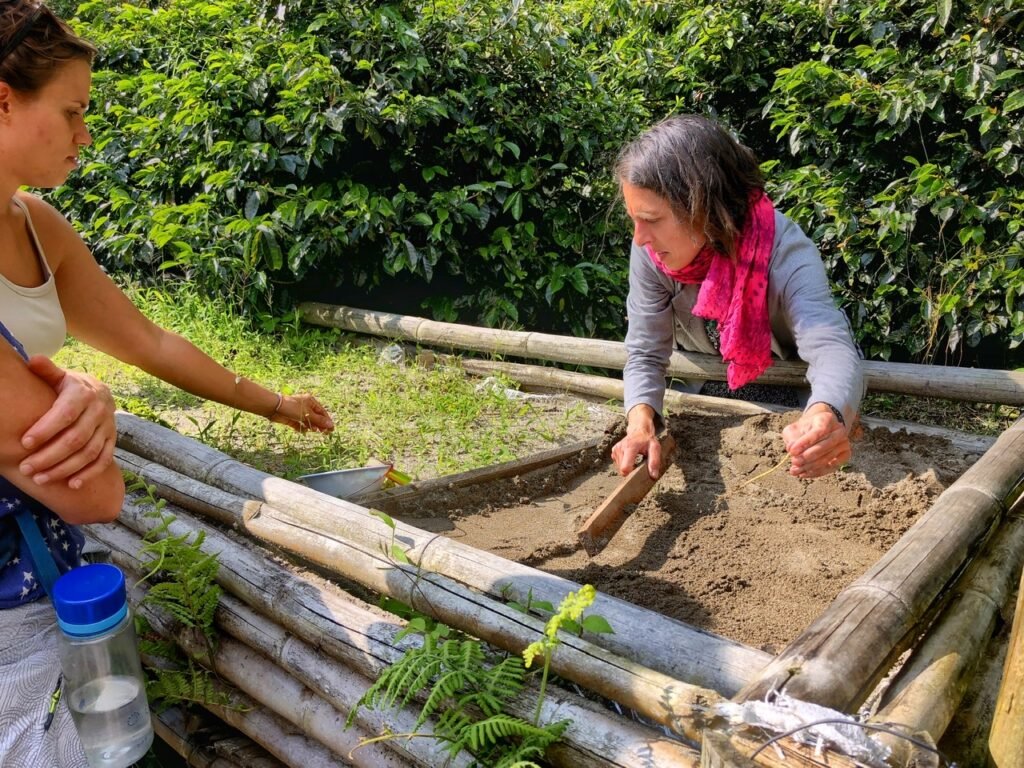
Carla covering up our babies.
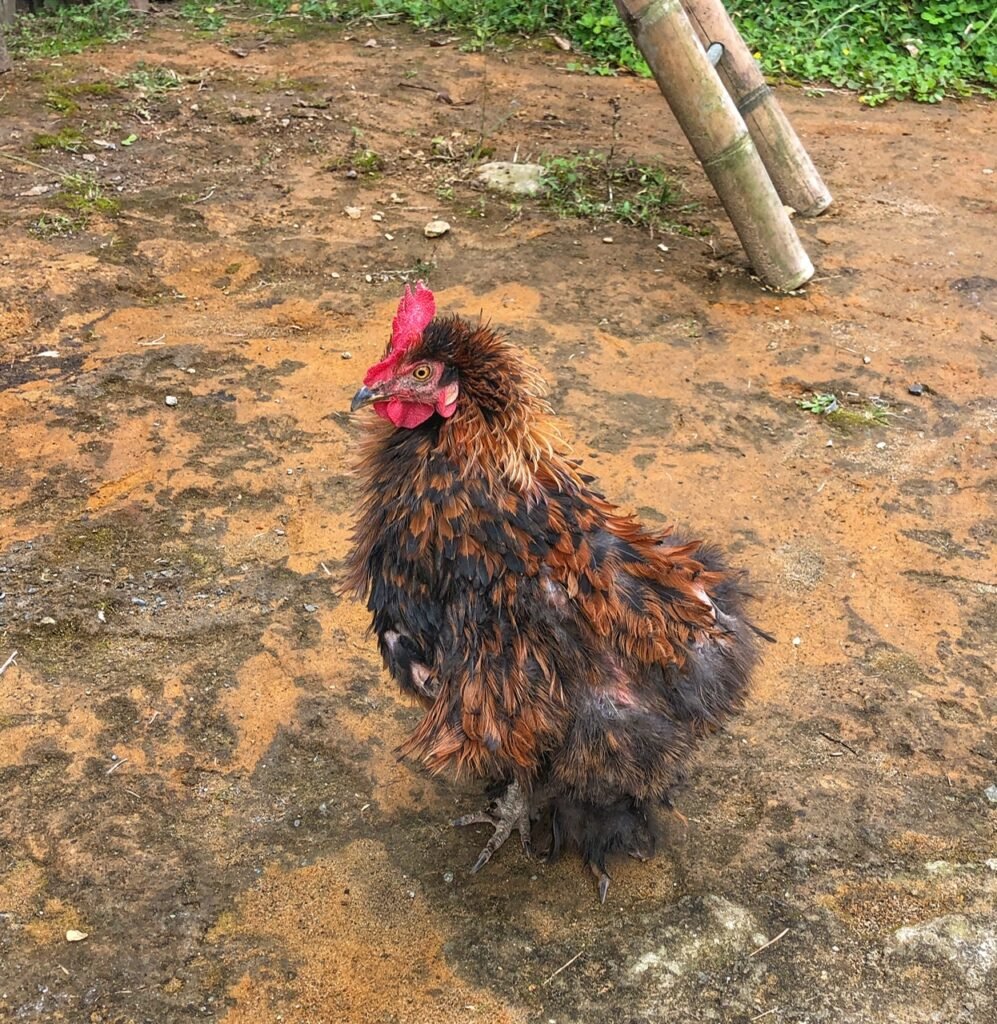
This poor rooster looks like he got into a love triangle in the hen house.

On the tour, we were surprised to see that the farm also had around 30 native Quindio wax palms. This was the tallest and oldest one at 100 years old.
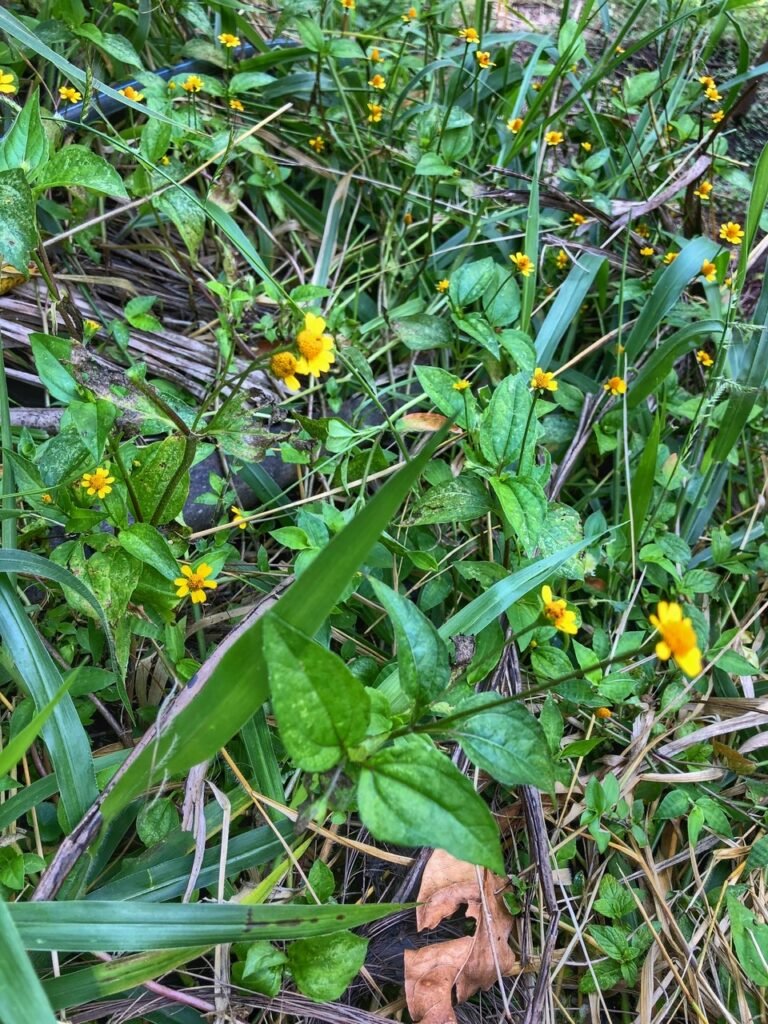
Despite the fact that malaria continues to be a very lethal disease worldwide killing 400,000 annually, it gets very little attention. This plant, Artemisia Annua, with buttercup yellow flowers is used in traditional herbal medicine to fight malaria.
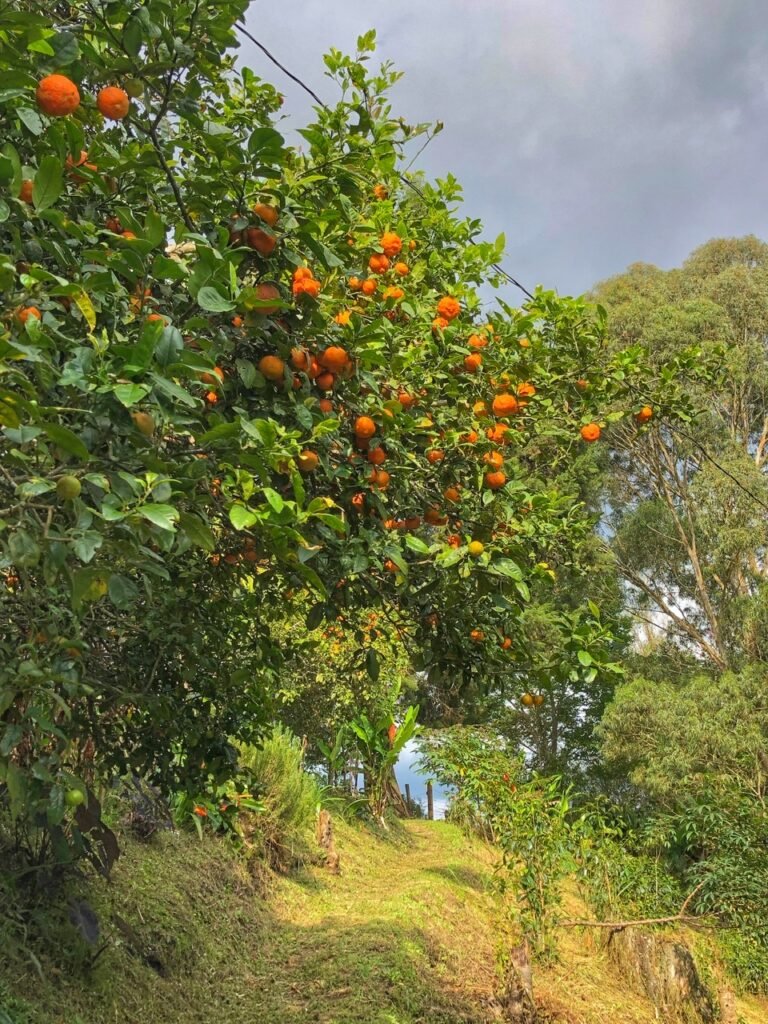
On the farm, there were tons of trees boasting what appeared to be plump and delicious oranges.

Although Carla mentioned they were a “bit” sour, Abby had to confirm. ?

This machine takes the husks off the coffee bean.
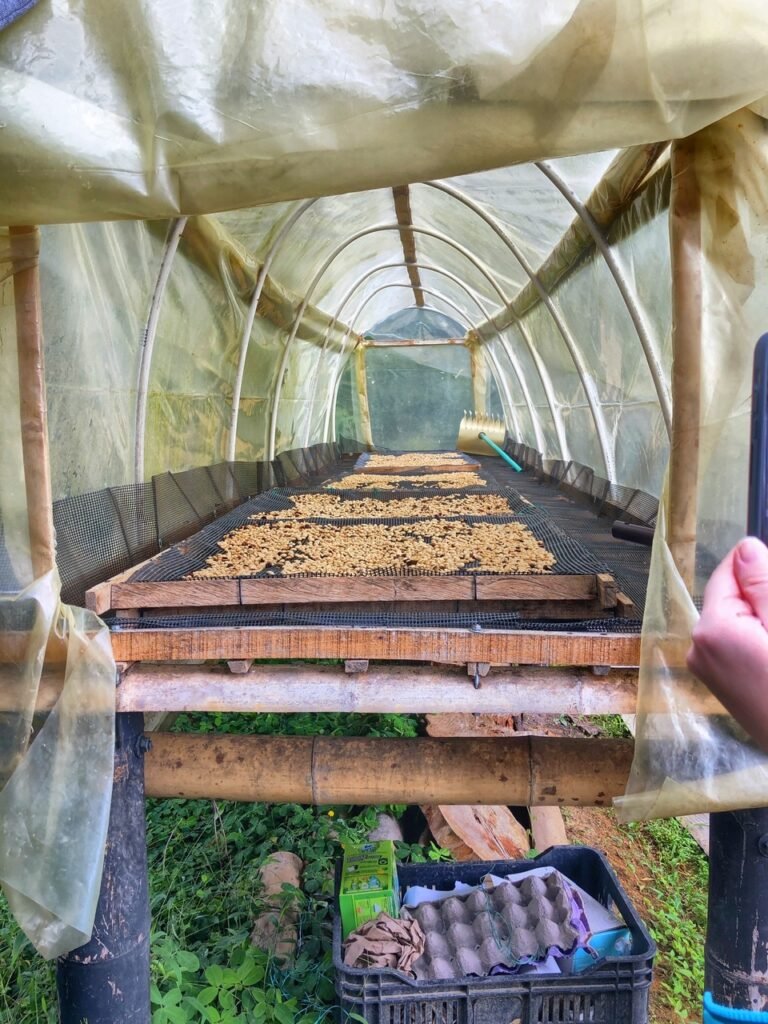
After being de-husked and washed, the coffee beans go to dry in what appears to be a platform bound for the Oregon Trail.
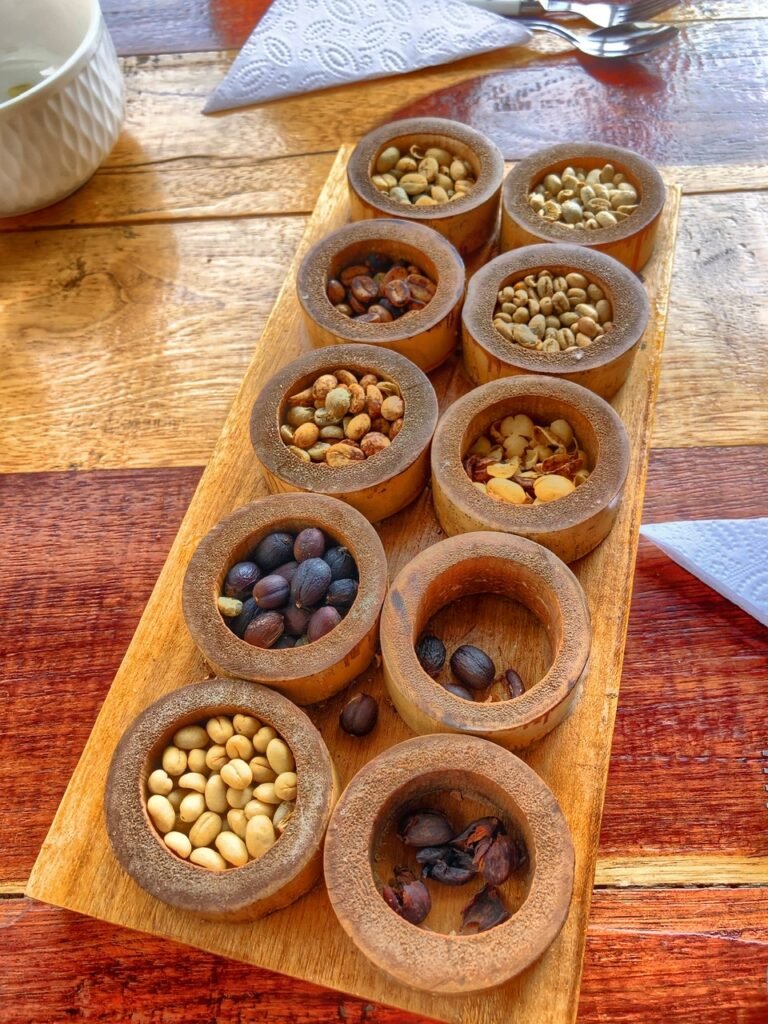
Sitting down for our coffee workshop, Carla presented us with a whole tray of beans in various stages of production to sample and view. There are two major types of coffee: 1) Arabica, which is pricier and more desirable, and is 60% of the world’s coffee production with a sweeter, softer, and more acidic taste) and, 2) Robusta with a harsher, stronger taste which is generally found in cheap supermarket coffee. It has more caffeine. There are also hybrid blends. If a coffee is 51% Arabica and 49% Robusta, it’s labeled Arabica.

Part of the workshop was allowing us to sample coffee being prepared using five different methods: Moka, French Press, V60, Chemex & Aeropress.
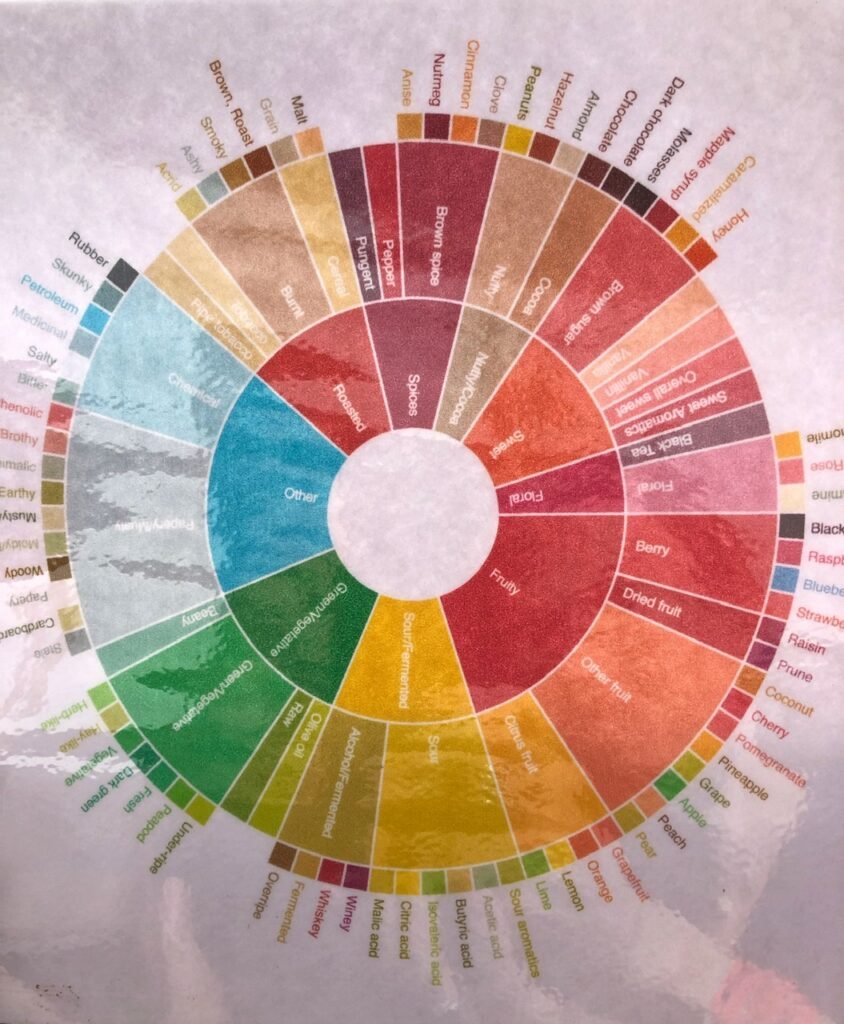
Like any other tasting, we were invited to sample the coffees and then place descriptors on them using this helpful taste wheel.

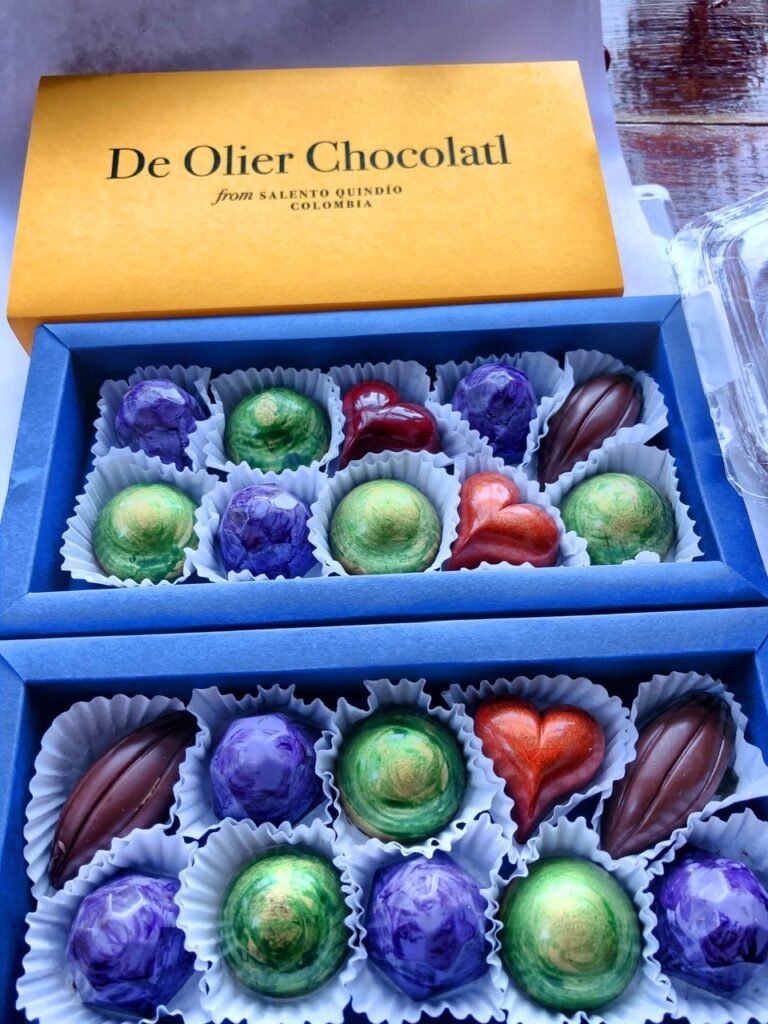
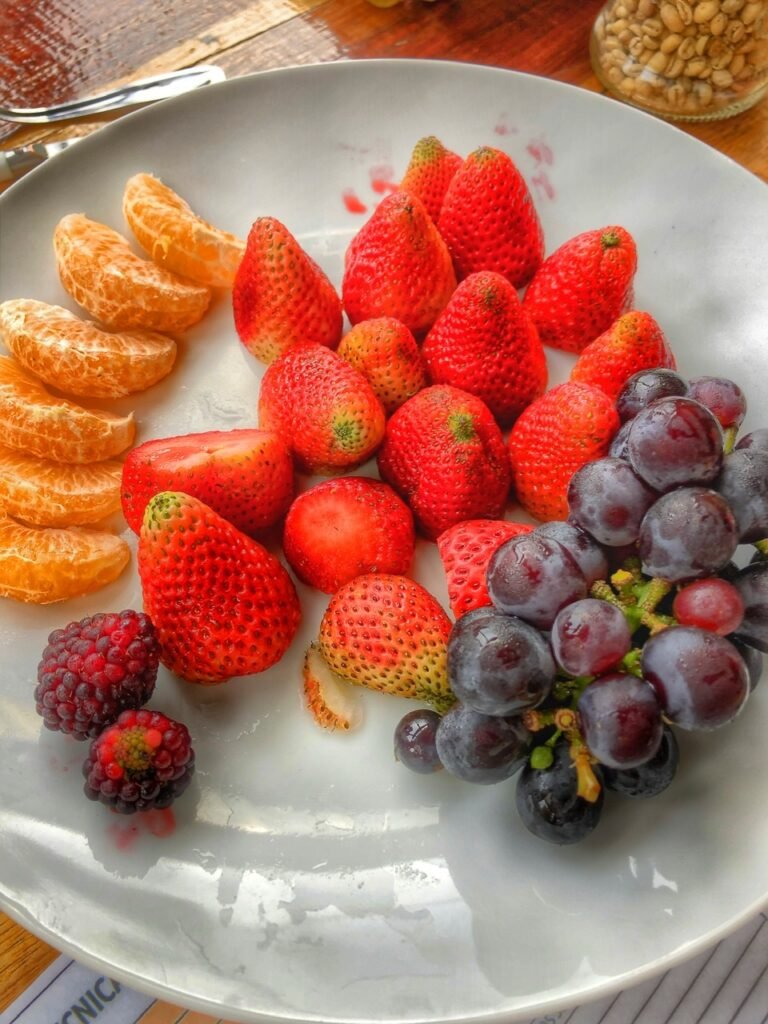
She also provided us with multiple pairings including fruits and beautifully crafted chocolates.

The Aeropress, which definitely produced some of the best coffee we’ve ever had. You definitely don’t need milk or sugar with these little cups of wonder. This rapid brewing process extracts the most flavor from the beans, giving it a more rich, pure tasting coffee with no grit, no bitterness and less acidity. We were able to taste flavors in the coffee we didn’t even know existed.
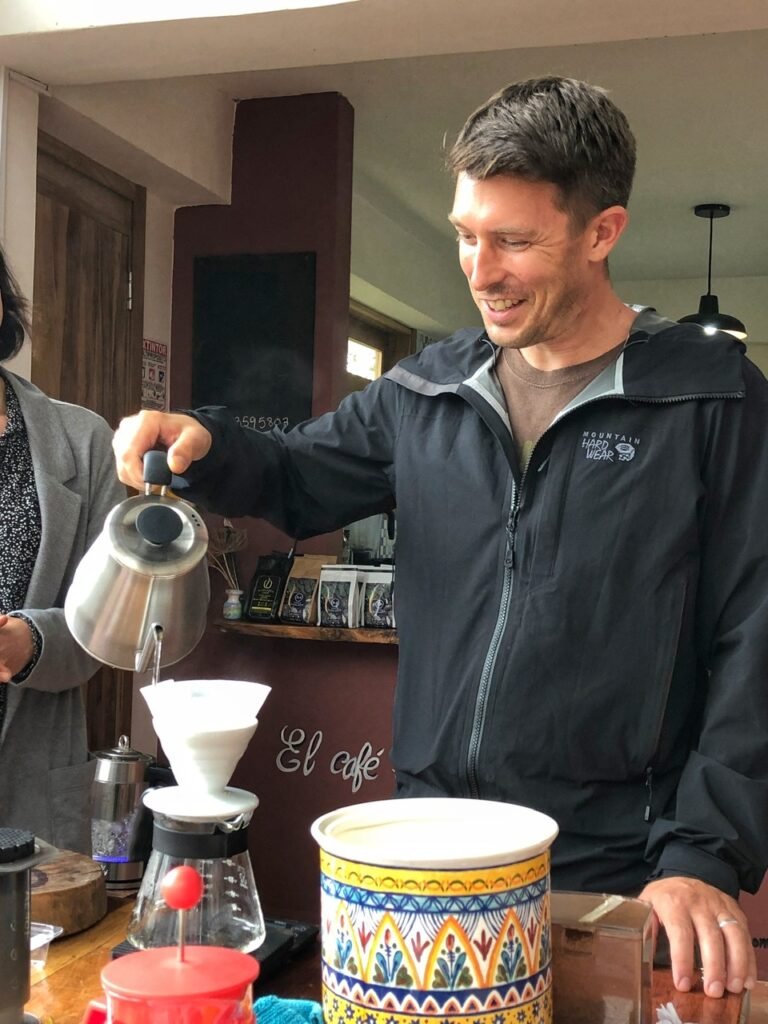
Greg putting back on his brewing hat to do a demonstration with the V60 Coffee Dripper. V stands for the cone-shaped filters and 60 represents the sloping angle of the dripper’s sides. It was also exquisite. Drip coffee (yes, it’s slow), is all the rage in hipster coffee shops.
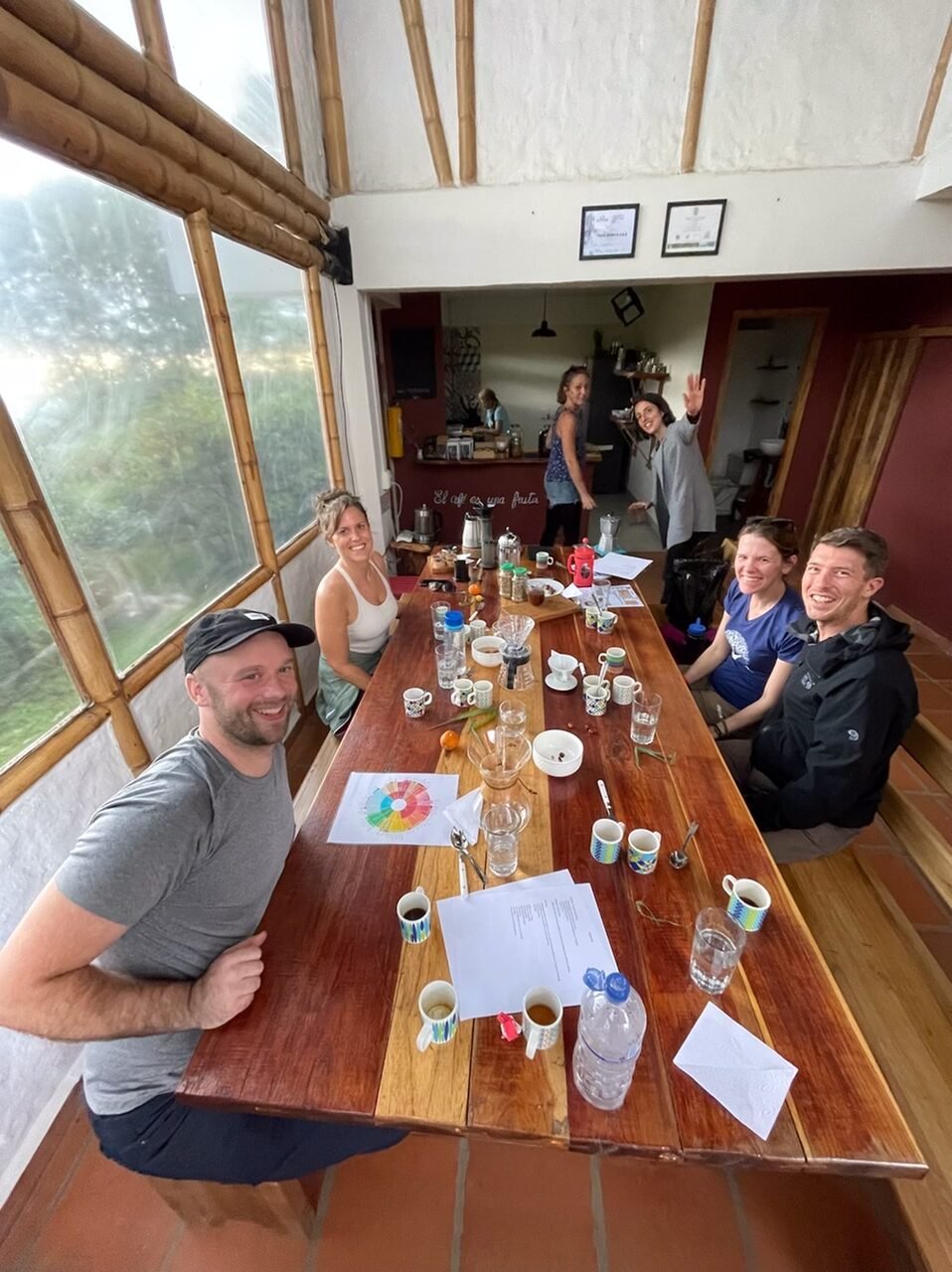
Our coffee table. Ha.

Mandy doesn’t drink caffeine anymore so this is what it did to her.
Valle de Cocora (Cocora Valley)
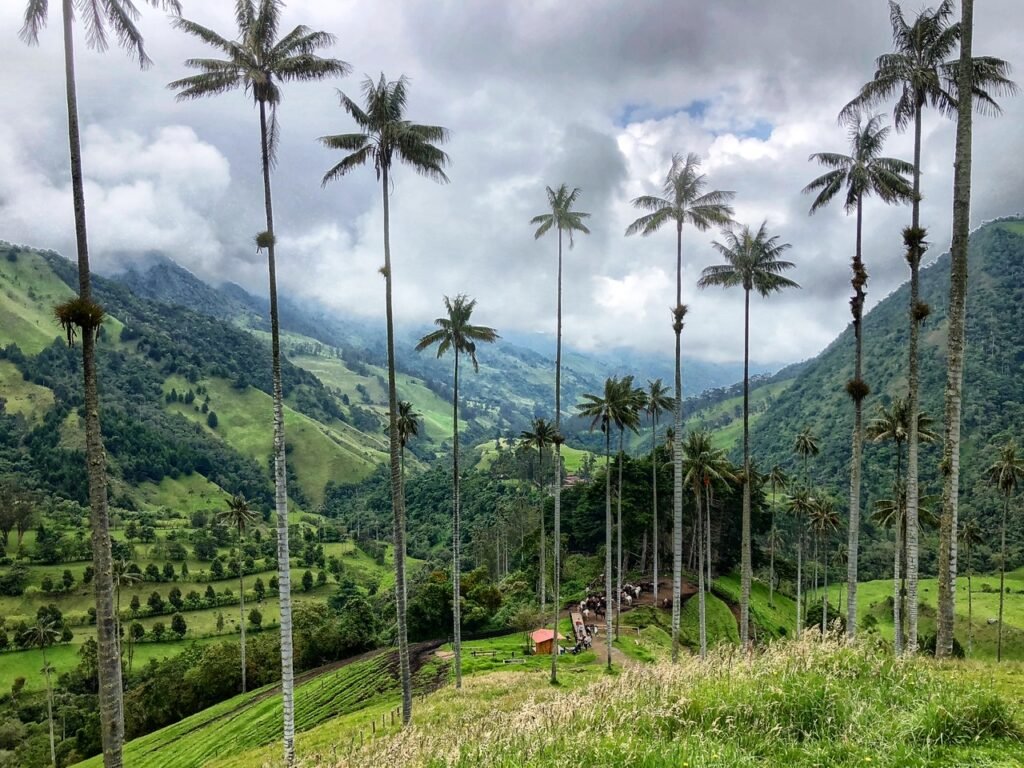
If you want to feel like you’ve meandered into a whimsical land fabricated by Dr. Seuss, look no further than Colombia’s Cocora Valley just outside of Salento. This otherworldly panorama features thousands of Quindio Wax Palm trees, the tallest palms in the world, which are native to this part of Colombia and can grow up to 200 feet (60 meters). The trees soar to the sky in a habitat normally considered too cold for palms…up to around 3000 meters (9800 feet) above sea level. You will not see anything like this anywhere else in the world and for this reason, they are a source of national pride and symbol for the country.
They are thankfully now, also legally protected in this wildlife sanctuary. It wasn’t always this way. In the past, the wax palms have unfortunately been threatened by habitat loss, over-harvesting, and disease. At one time, droves of Catholics over-plucked leaves from young trees to use during Palm Sunday, which damaged and even killed the young trees. The trees were also felled so people could use the waxy trunks to make candles. (Atlas Obscura)

Hopping in a Jeep Willy to take a spin around the valley. It’s fake, for the record.
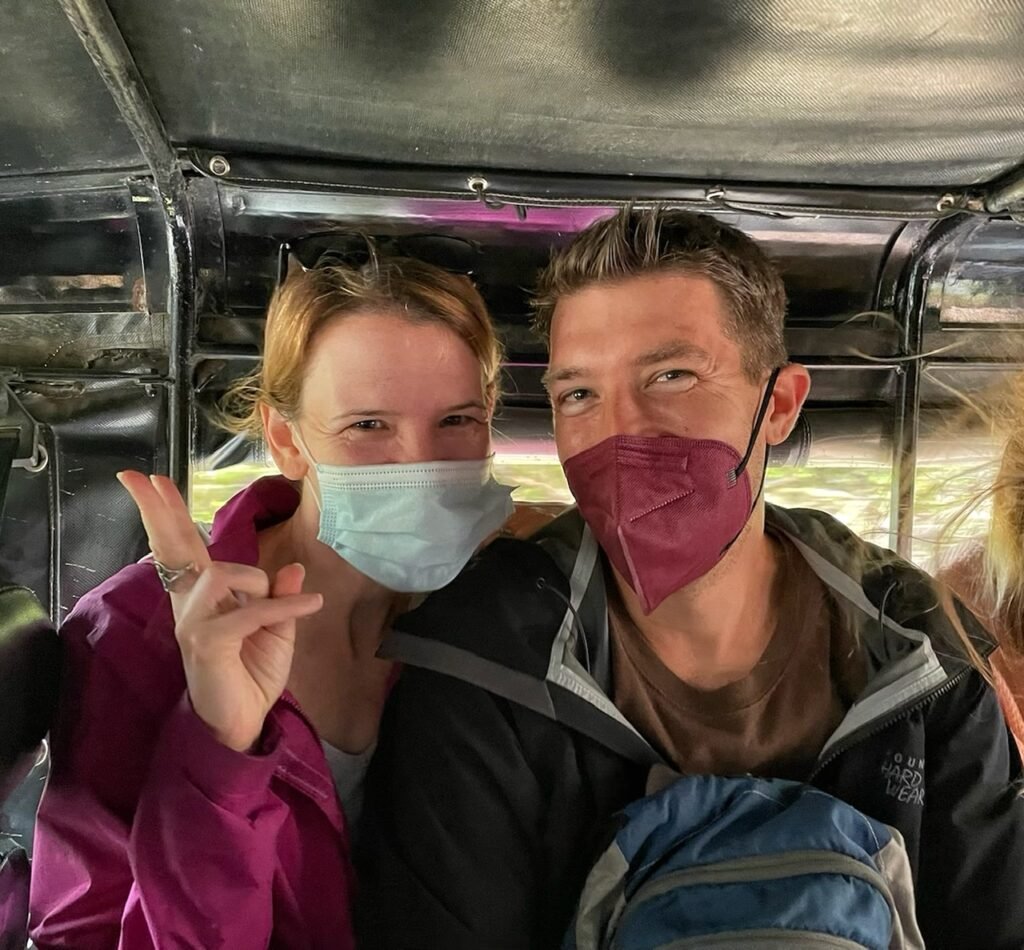

In reality, we did arrive by jeep, which leave from Salento about every 30 minutes for $8000 pesos each ($2). Expect to wait awhile for your ride, however. This is one of Colombia’s premiere tourist attractions and unfortunately you can only cram about 10 people inside…
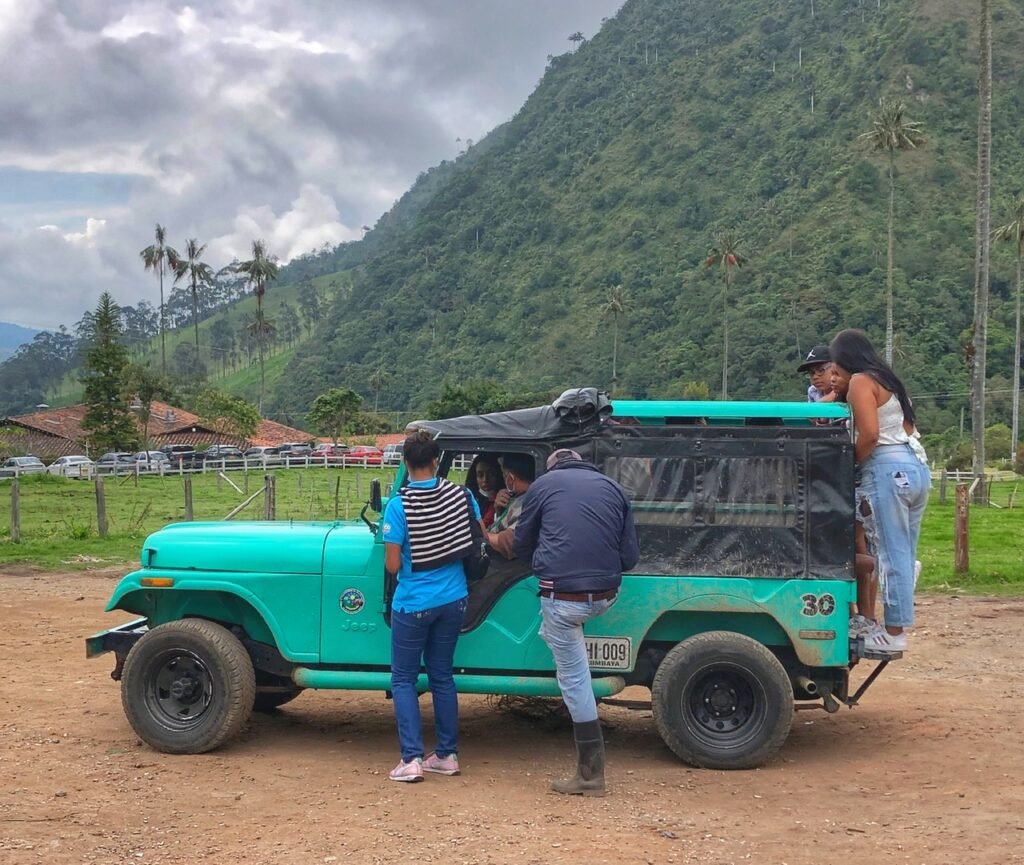
…with three hanging off the bumper for this 30-minute ride. The truth of the matter is, it’s kinda unnecessary to take a jeep. We thought it was gonna be a rough and tumble ride, and feared for those people chucked on the back, but actually the road was smooth and mostly straight. But, alas, I guess it’s all about the experience.
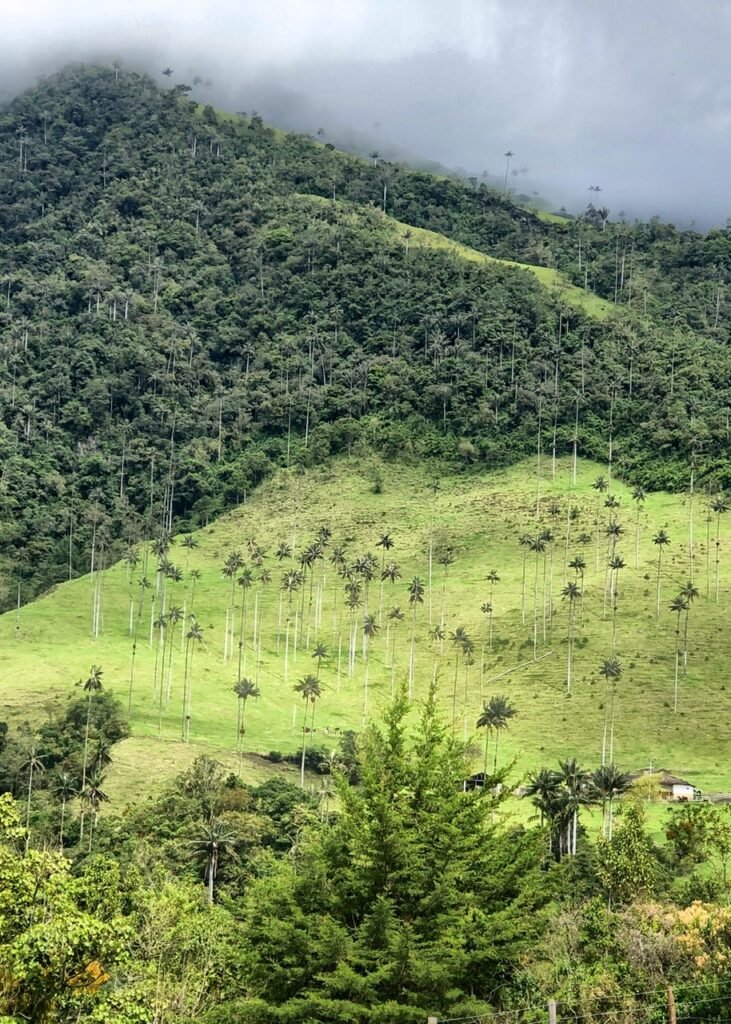
This was the first vista we saw upon arrival to the valley.
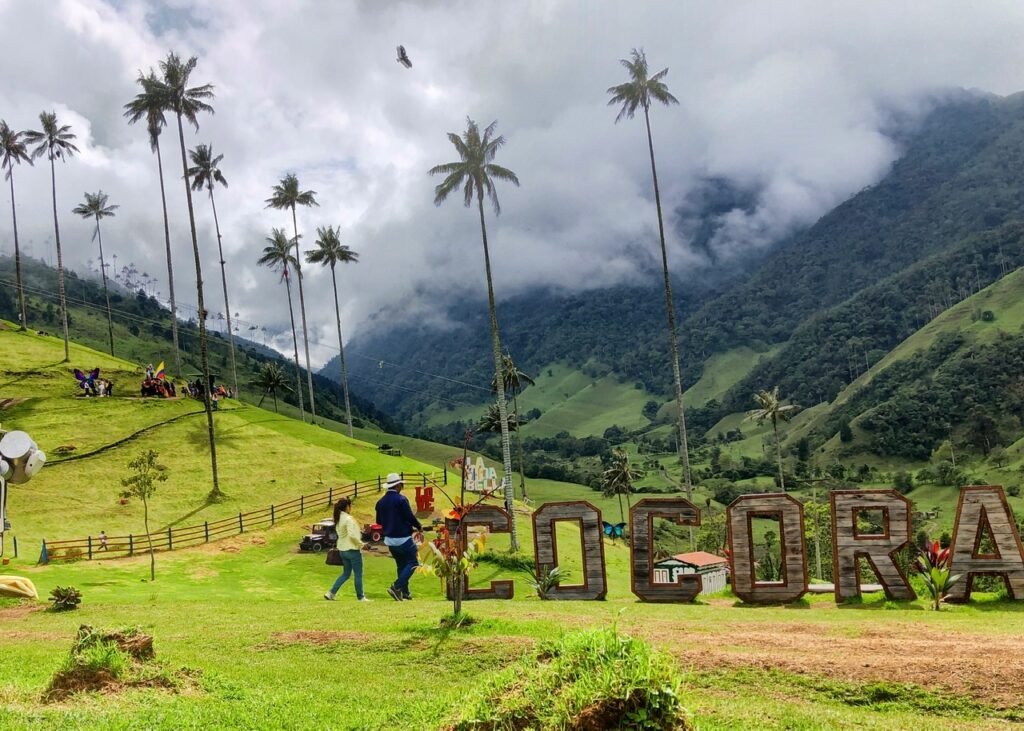
The photo opps are endless.

Quindio wax palms are named after the state in which they grow. These towering giants can live up to 200 years and in the past, were often used to make wax. Its stem is covered by a layer of wax that can be used to make candles.
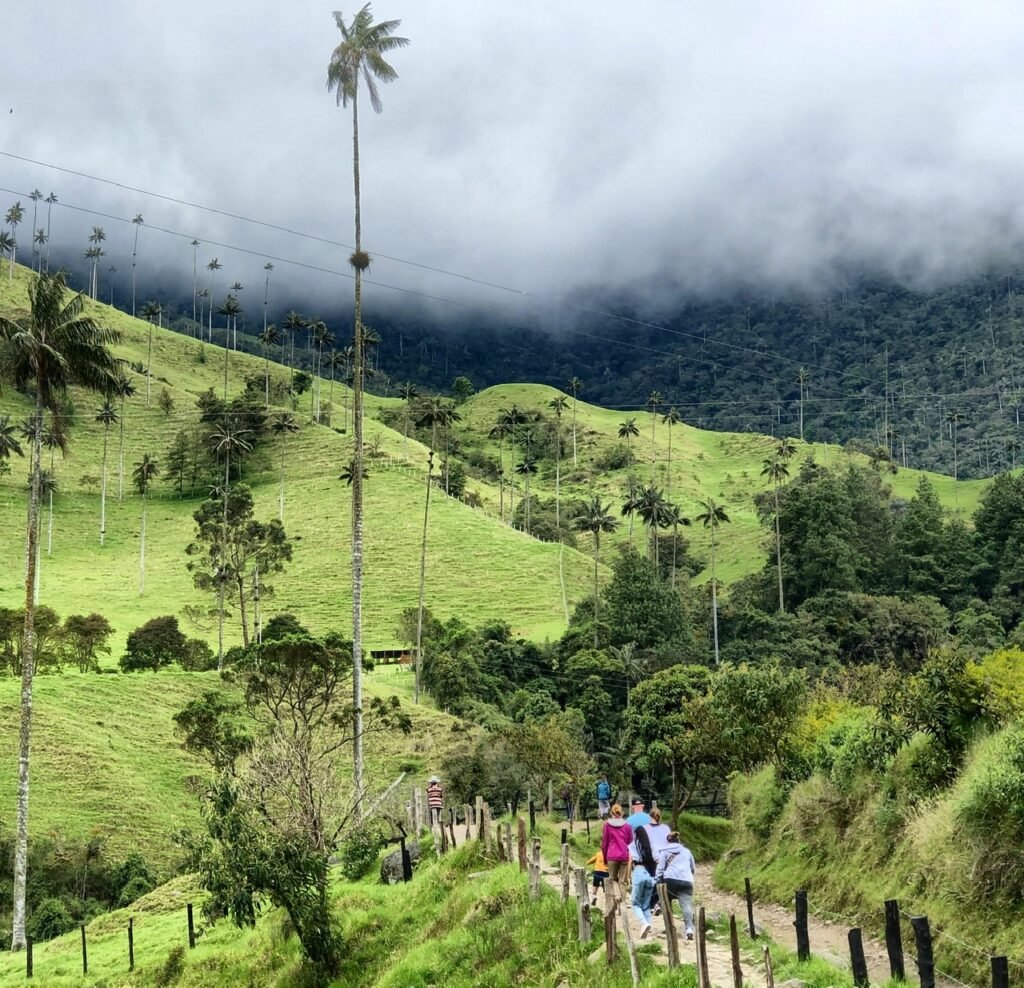
Throughout the valley, there are multiple trails and walking paths.

A seedling takes around 50 years to reach the adult phase. If only we aged this gracefully. Ha!
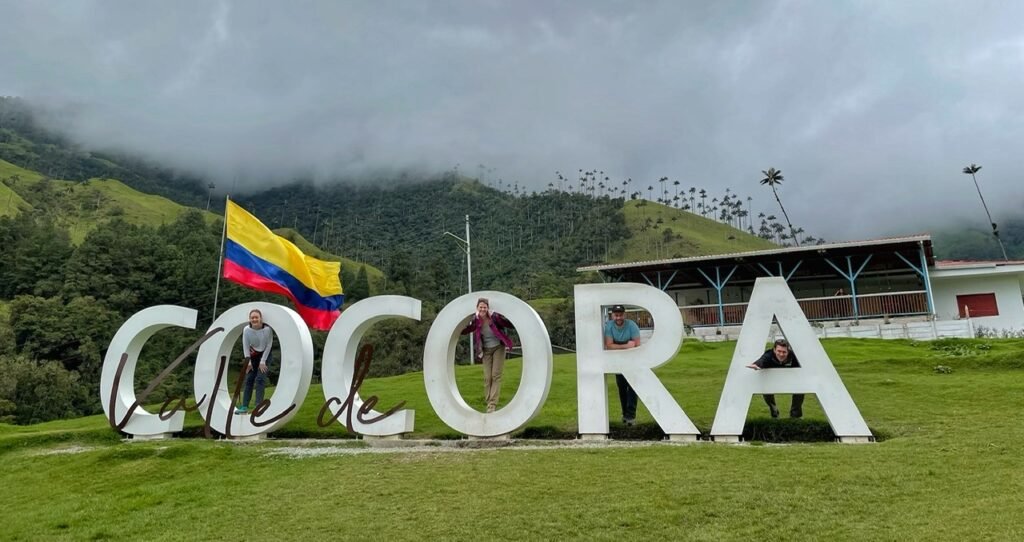
Mandy, Abby and Alex gleefully tuck themselves into the photo opp.
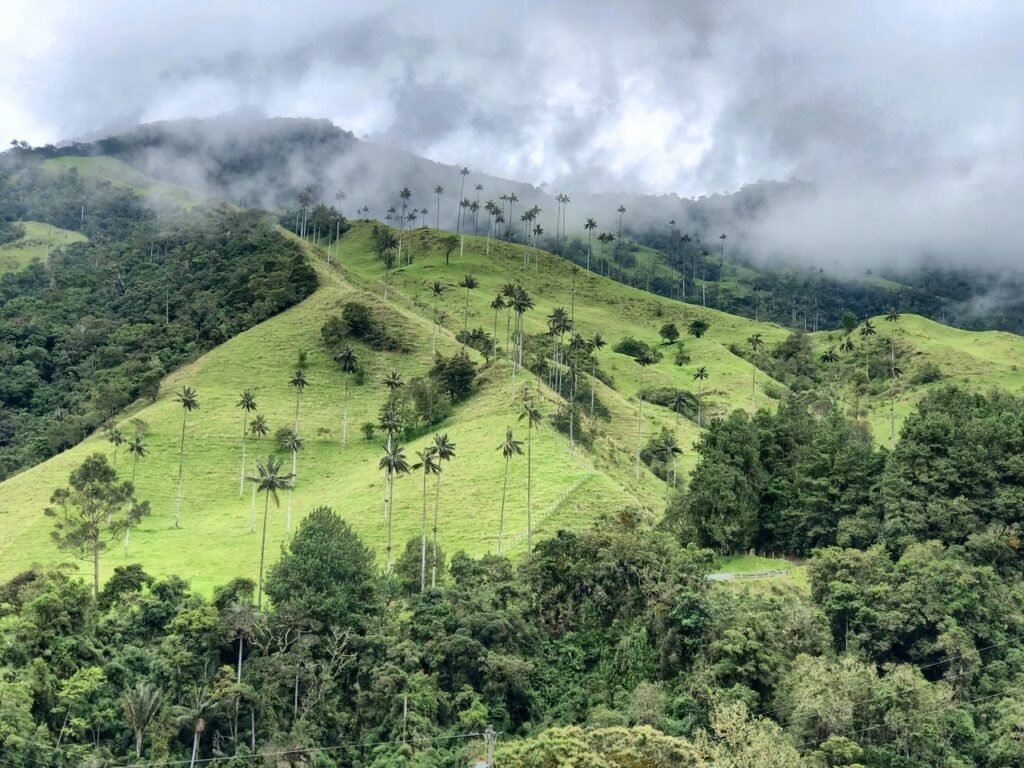
Tucked up into the cloud forest, it’s probably one of the most ethereal-looking places we’ve visited.
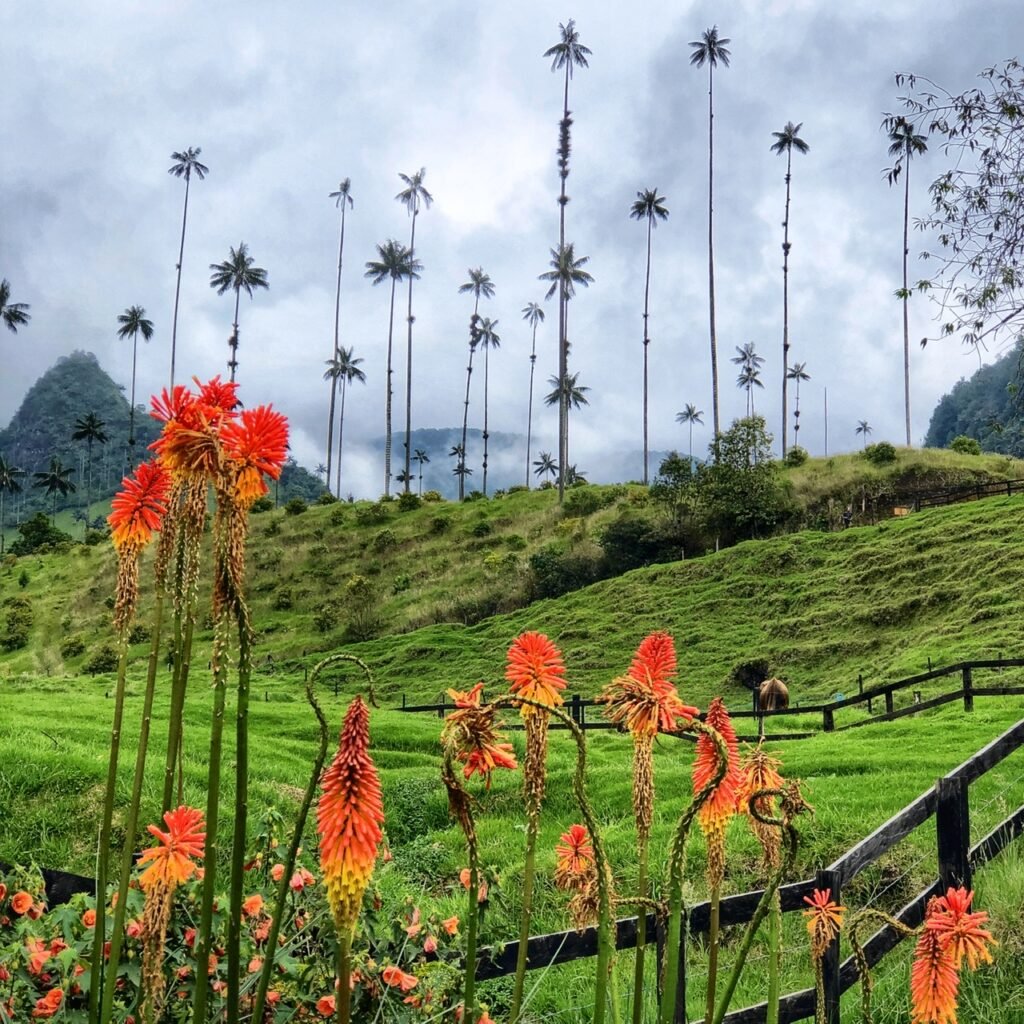
What a stark contrast!
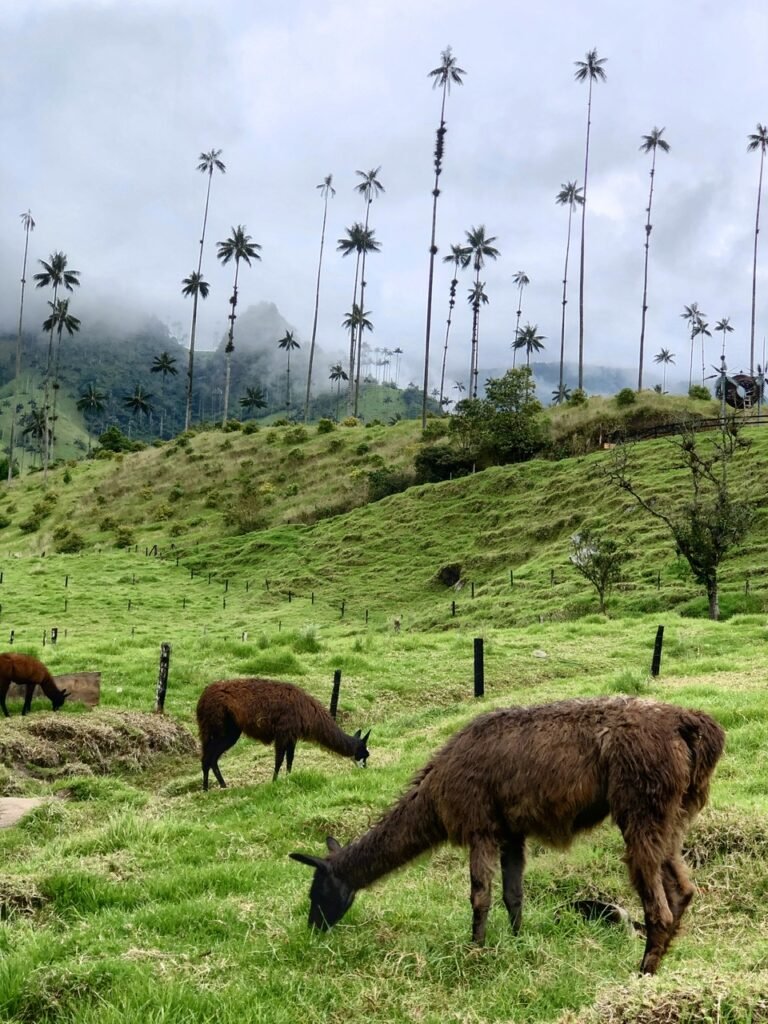
Our first South American alpacas!!
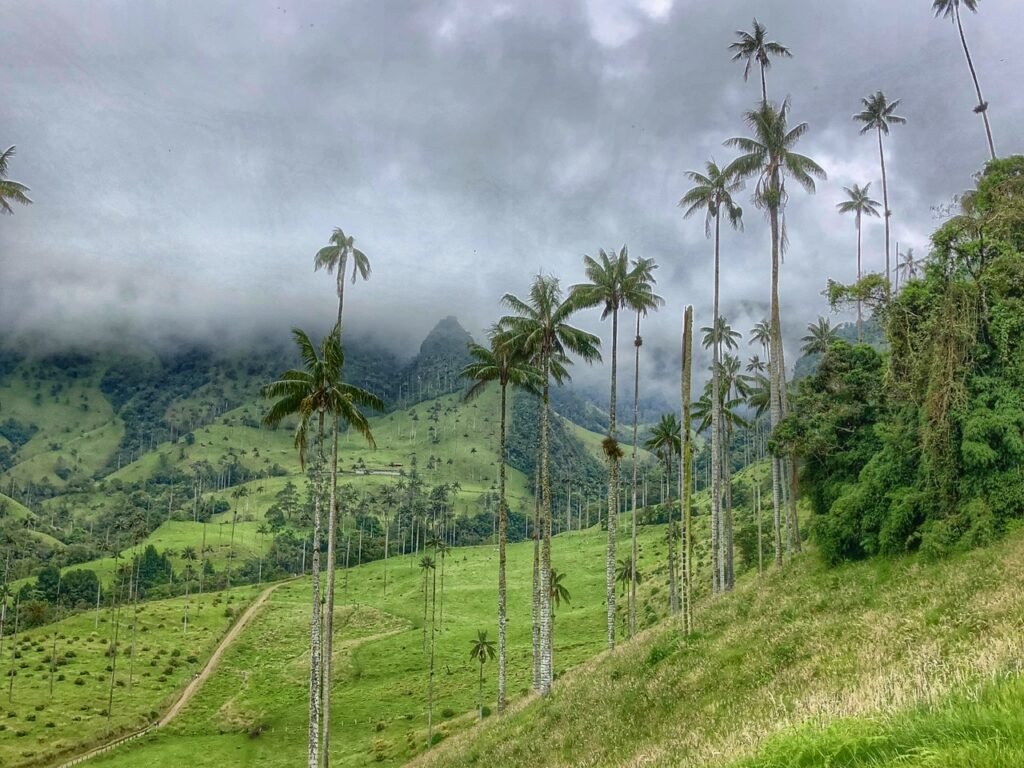
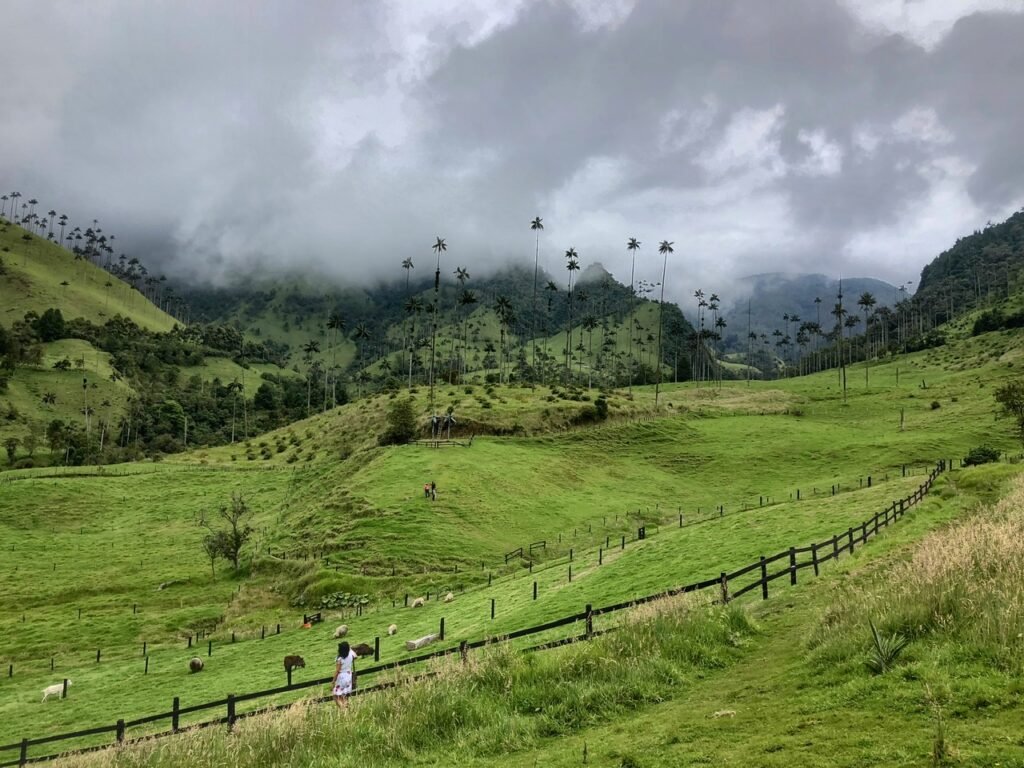
Gazing across the verdant valley.

Trying to capture the monstrosity of these trees is not easy.
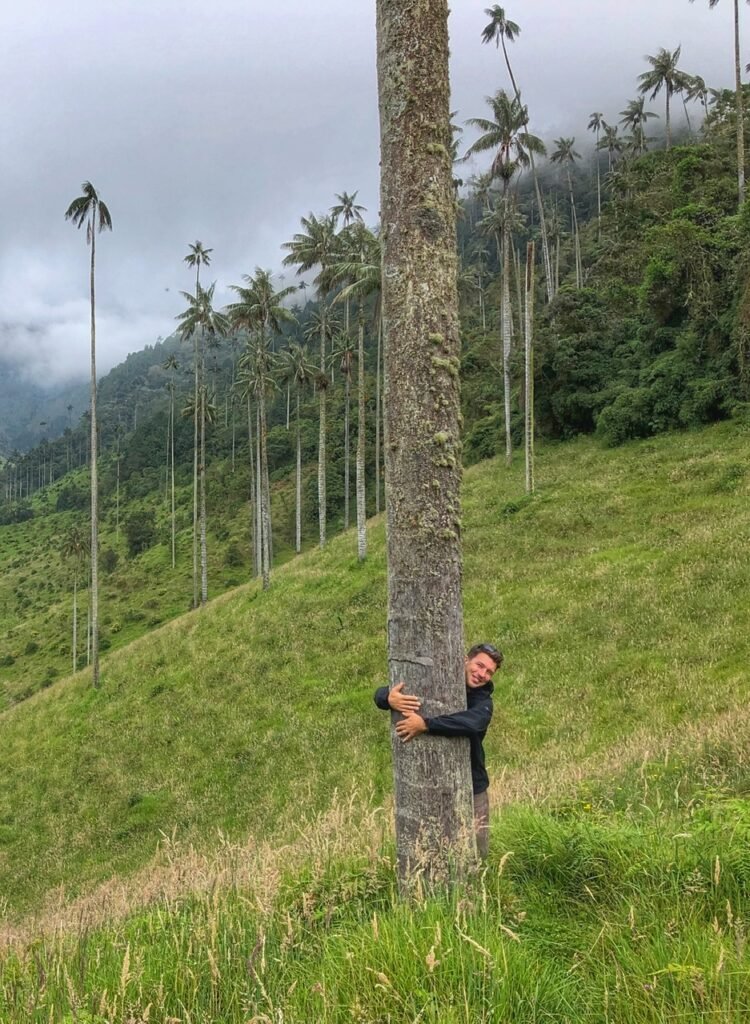
And despite their height, they are still spindly enough to give a good tree squeeze.
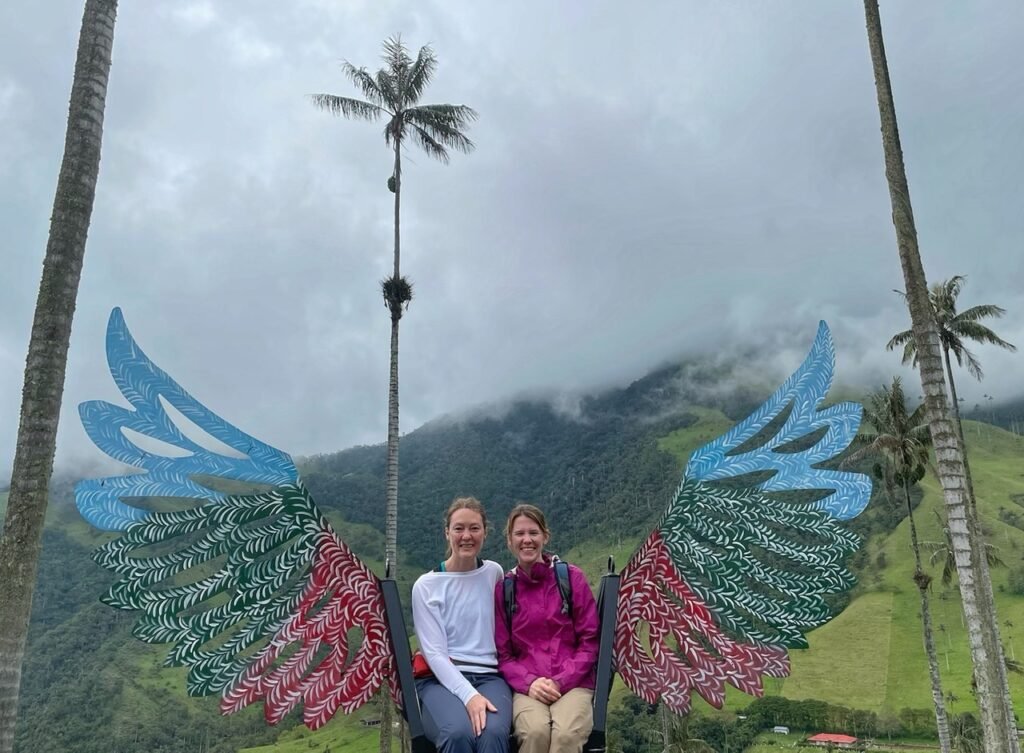
Mandy and Abby ready to fly away. For those who know Abby and Mandy’s history, this picture will be particularly noteworthy.
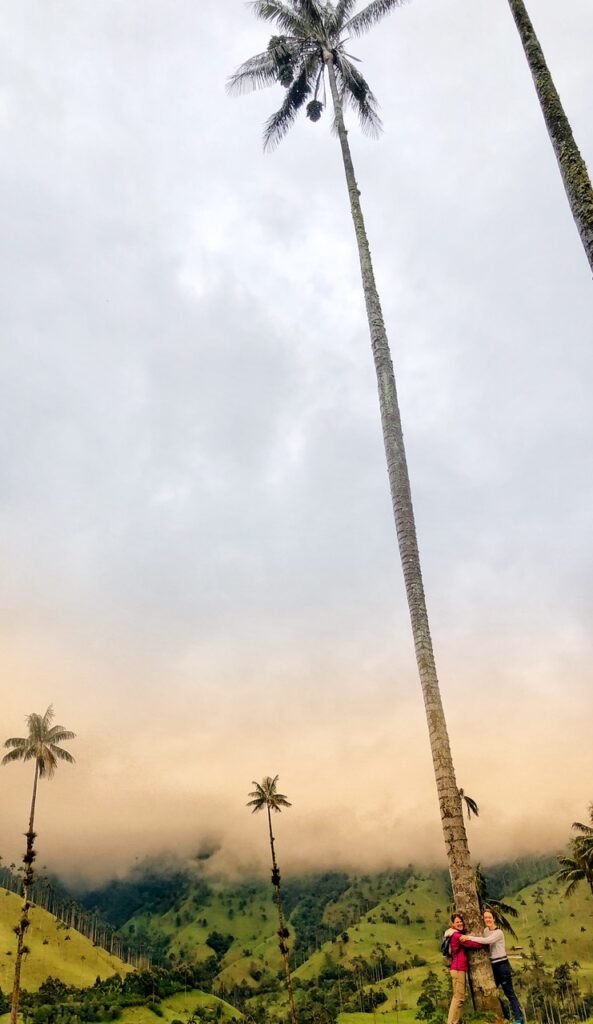
This really puts their gigantic size in perspective!
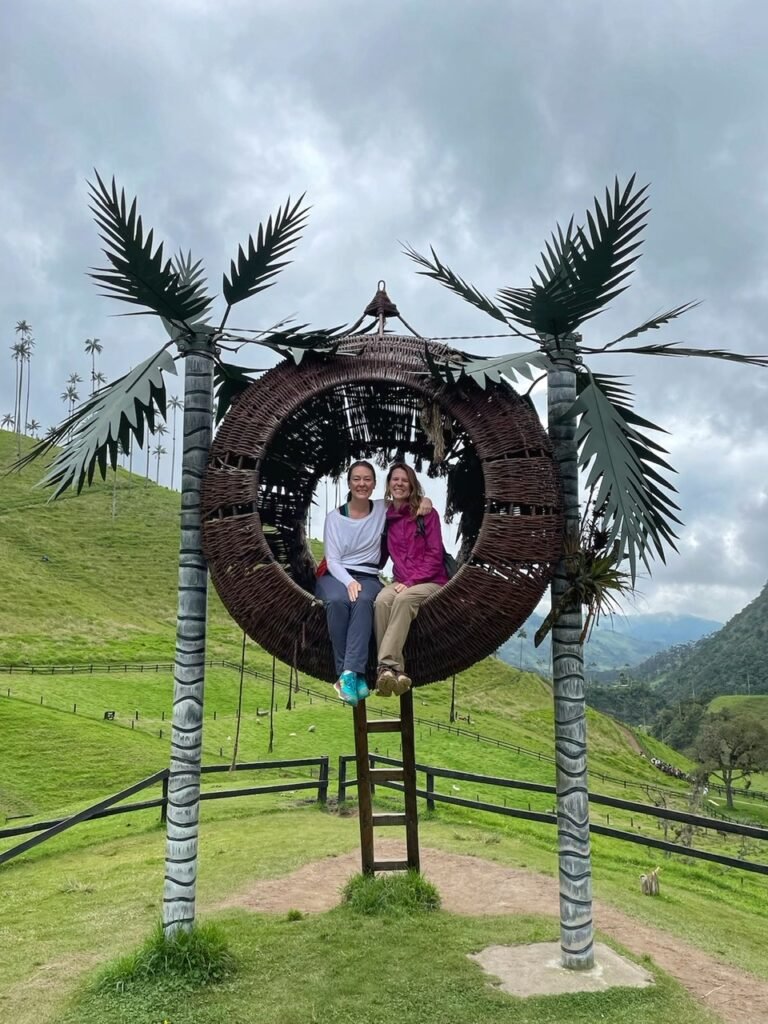
Friends hanging out in a coconut. Because it’s a healthy place to be. That’s why!


